A bloody war or a sickly season: The East Yorkshire Regiment’s Regular Officers of August 1914 and the Great War
- Home
- World War I Articles
- A bloody war or a sickly season: The East Yorkshire Regiment’s Regular Officers of August 1914 and the Great War
Recently, in a fit of tidy-mindedness, I went through my digital files to see if there was anything I could consign to the Recycle Bin. My eye fell on a folder entitled ‘East Yorkshire Regiment’. I hadn’t looked at this for ages. More years ago than I care to recall, my late and much-missed friend Peter Lawrence told me that he’d had a ‘good idea’. Pete was good at good ideas. "I think we should take a British infantry regiment and find out what happened to its Regular officers who were on the Active List in August 1914," he explained.[1] "Good idea," I replied. "Which regiment?" We decided that Pete would "choose one at random". I don’t know what random method of selection he adopted. I suspect it involved a list, a blindfold and a pin. Fate fell upon the East Yorkshire Regiment. Pete was very much a man of the Midlands and had no connections with Yorkshire or previous interest in the East Yorkshire Regiment. He began the preliminary work, but died tragically young before he got very far. The project was eventually put to one side, where it has remained until now. I decided to revisit Peter’s work and add to it, something made much easier by the transformational possibilities of the internet.
The Regular Battalions of the East Yorkshire Regiment
The East Yorkshire Regiment, like most British infantry regiments, had two Regular battalions, one stationed at home and one stationed abroad.
The 1st Battalion was based at York. It was mobilised as part of the BEF, in 18 Brigade (Brigadier-General E.C. Ingouville-Williams), 6th Division (Major-General J.L. Keir).[2] It moved to Edinburgh on 8 August, then to Cambridge on 14 August, landing at St Nazaire on 10 September 1914. It thus missed the early fighting and the Retreat from Mons. The Battalion’s commanding officer was Lieutenant-Colonel R.E. Benson.

Above: Lieutenant-Colonel R.E. Benson
He had been appointed CO on 15 August 1911 at the age of 48. This was par for the course with regard to infantry battalion command appointments in the Edwardian army. Ordinarily, Benson could have expected to serve a four-year tour as CO, ending in August 1915, before being promoted to full colonel, at which point his career would either have stalled or he would have moved on to a higher appointment or command.[3] As he had not passed staff college, the latter was unlikely.[4] The 1st Battalion joined the war in earnest on 19 September 1914 on the Aisne before being heavily engaged in the battle of Armentières (13 October-2 November), during the so-called ‘race to the sea’. The battalion was not involved in any of the major British offensives of 1915. 6th Division’s only engagement in 1915 to attract the notice of the post-war Battles Nomenclature Committee was ‘Hooge’, an insalubrious place and the site of the notorious German ‘liquid fire’ attack of 9 August 1915. On 26 November 1915 1st East Yorkshire (by then under the command of Lieutenant-Colonel J.L.J. Clarke)[5] was transferred to 64 Brigade (Brigadier G.M. Gloster), 21st Division (Major-General C.W. Jacob), as part of the rebuilding of 21st Division, following its disastrous baptism of fire at Loos. 1st East Yorkshire remained with 21st Division for the rest of the war.[6]
In August1914 the 2nd Battalion was based at Kamptee in India, under the command of Lieutenant-Colonel M.J. Sweetman. It was recalled from imperial service, landing in England in December 1914, assembling as part of 83 Brigade (Brigadier-General R.C. Boyle), 28th Division (Major-General E.S. Bulfin) at Hursley Park, near Winchester. The battalion landed at Le Havre on 16 January 1915. Having been rushed from the heat of India to the cold and damp of northern France in the space of a few weeks the battalion experienced considerable problems of adjustment, suffering badly from frostbite.[7] Its first major action was on 22 and 23 April 1915, during the German gas attack against the Gravenstafel Ridge, followed by further fighting round Ypres, at St Julien (24 April-4 May 1915), on the Frezenberg Ridge (8-13 May 1915) (where it did well) and on the Bellwaarde Ridge (24 and 25 May 1915). The nature of the fighting was an unrelenting series of attacks and counter-attacks that belied the neat demarcations of the Battles Nomenclature Committee and was characterised by the Official History as ‘desperate fighting in a desperate position at the point of a salient’.[8] 28th Division’s time on the Western Front concluded with its participation in the battle of Loos (27 September-5 October), when it continually fell foul of the GOC I Corps, Hubert Gough.[9] Bulfin, who went home during the battle, recalled the experience of Loos as ‘a sort of horrid nightmare’.[10] On 26 October 1915 28th Division was transferred to the new Salonika theatre. 2nd East Yorkshire (by then under the command of Lieutenant-Colonel W.A. Blake)[11] sailed from Marseilles, arriving at Alexandria on 3 November and Salonika on 3 December. The battalion remained at Salonika for the rest of the war.
This pattern was not atypical of the experience of Regular infantry battalions. Eight Regular battalions (out of a total of 155) remained in India throughout the war.[12] A further 38 battalions served for the whole or part of the war away from the Western Front.[13]
The East Yorkshires’ Regular Officers
In August 1914 there were 66 Regular officers in the East Yorkshire Regiment: two lieutenant-colonels; eight majors; twenty captains; twenty-five lieutenants; and eleven second lieutenants. To these should be added another two second lieutenants who received Regular commissions in August 1914, but after the declaration of war. Both deployed to France in September 1914, but with the 2nd Battalion Duke of Wellington’s Regiment. There were also three Special Reserve officers, all second lieutenants, listed under ‘1st and 2nd Battalions’.[14] Most officers were shown as attached either to the 1st or 2nd Battalions, though a number were on extra-regimental or extra-battalion duties. Major J.L.J. Clarke was DAA&QMG Coast Defences, Eastern Command. Captain T.A. Headlam was an Instructor (GSO3) at the School of Musketry, India. Captain C.P. Berthon was Adjutant of the 3rd(Reserve) Battalion East Yorkshire Regiment. Captain F.H. Harvey and Lieutenant J.A.F. Mair were shown as employed with the Army Signal Service, but in fact Harvey had been a student at the Staff College since 22 January 1914. He was among a number of officers who were considered to have passed staff college following the outbreak of war.[15] Captain J.B.O. Trimble and Lieutenant M.B. Stow were serving with the Indian Volunteers, Trimble as Adjutant. Lieutenant W.S. Browne and Lieutenant J.B. Porter were serving with the West African Regiment. Lieutenant R. Wallace was Superintendent of Physical Training, India.
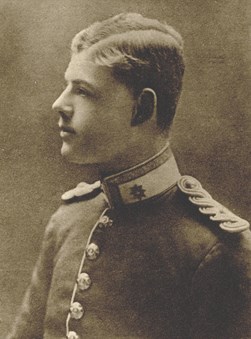
Above: Lieutenant (later Captain) Robert Wallace (died of wounds 6 May 1915)
A few officers, although officially attached to one or other of the Regular battalions, were not currently serving with them. Major H.G.A. Moore (2nd Battalion) was commanding the regimental depot in Beverley and attached to the 3rd Battalion. Captains E.F. Twiss (2nd Battalion), A.R. Kino (1st Battalion) and D.G. Wrangham (2nd Battalion), Lieutenants J.H. Coles (2nd Battalion) and A. Grant (1st Battalion) were all also attached to the 3rd Battalion.

Above: Major Henry Moore (died as the result of a bayonet wound at Suvla Bay, 9 August 1915)
The twenty-four officers actually serving with 1st Battalion in August 1914 were, therefore: Lieutenant-Colonel R.E. Benson (CO); Majors W.H. Young and W.E. Campion; Captains B.W. Bogle, A.H. Wilson, E.L.P. Edwards, B. Lawrence, D.F. Anderson (Adjutant), F. Hind, M.G. Cowper and P.B. Maxwell; Lieutenants C.L. Leadley-Brown, V.E. Inglefield, F.H. Sasse, J.A. Markham, H.S.F. Cosens and N.V. Blacker; 2nd Lieutenants G.R. Smallwood, P. Clutterbuck, T.M. Robson, R.T.F. Scott, F. Carruthers, H.L. Willats and J.A. Hartcup. Three of these officers did not proceed with the battalion to France. Cowper, Carruthers and Willats were retained at home to help with raising and training the New Army, a pattern repeated throughout the battalions of the original BEF. They were replaced by three Special Reserve Officers, 2nd Lieutenants M.R. Pease, A.W. Meller and T.R. Bottomley, and by Lieutenant Hutchinson, who despite being listed as a 2nd Battalion officer, deployed to France with the 1st Battalion. This takes the number of officers who landed in France to twenty-five.[16]
The 2nd Battalion’s twenty-six officers were: Lieutenant-Colonel M.J. Sweetman (CO); Majors W.H. Armstrong, H.H. Powell, T.R.E.W. Warren-Swettenham and W.N. Pike; Captains O.C. Wilkinson, C.P.B. Riall, L.G. Hill, R.S. Hopkins and K.T. Woodmass; Lieutenants E.A. Bray, G.D.A. Douglas, K.A. Plimpton, H.F. Wailes (Adjutant), H.C.R. Saunders, A.G. Ottley, B.S.C. Hutchinson, W.W.B. Broadley, J.B.L. Noel, M. Eccles, A.E.C. Cart de Lafontaine and H.J. Hardiman; 2nd Lieutenants F.G. Prichard, O.J. Addyman, E.S. Wilson and P.N. Kennard. As we have seen, Lieutenant Hutchinson deployed with the 1st Battalion even though listed as being with the 2nd. Lieutenant Eccles transferred to the Indian Army on 13 August 1914, while 2nd Battalion was still In India. Major Armstrong was transferred to France to take command of 1st Battalion following the death of Colonel Benson. Armstrong held the command for only eight days (11-19 November 1914) before he himself was wounded, never to hold a command again. According to its War Diary, 2nd Battalion deployed to France on 16 January 1915 with twenty-six officers. The Diary, alas, does not provide a definitive list of who the twenty-six officers were, but we know that Lieutenant-Colonel Sweetman was CO. The company commanders were Major T.R.E.W. Warren-Swettenham, “A” Coy; Captain L.G. Hill, “B” Coy; Captain O.C. Wilkinson, “C” Coy; and Major W.N. Pike, “D” Coy. The Adjutant was Captain H.F. Wailes. Lieutenant O.G. Ottley was Machine Gun Officer.
A Bloody War
The early fighting had a devastating effect on the 1st Battalion’s officers and not just the junior ones. Colonel Benson was wounded in what Peter Hodgkinson has described as 'a futile charge’ on 20 September and died a week later. Captain E.L.P. Edwards, OC “B” Coy, was killed on 20 September, Captain A.H. Wilson, OC “D” Coy, on 18 October, and Major W.E. Campion, OC “A” Coy, on 28 October.
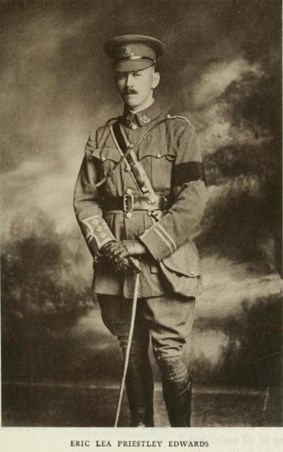
Above: Captain Eric Edwards
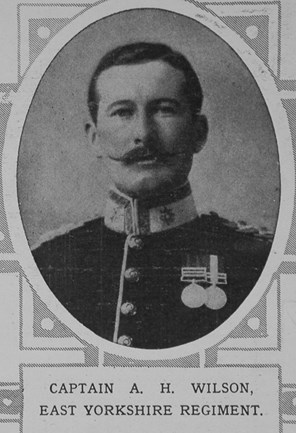
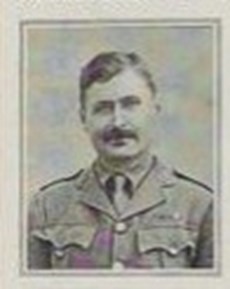
Above: Major W.E. Campion
By the end of October, Captain B.W. Bogle was the only one of the original company commanders left alive. Two of “A” Coy’s officers, 2nd Lieutenants P. Clutterbuck and A.W. Meller, were killed on 20 September.
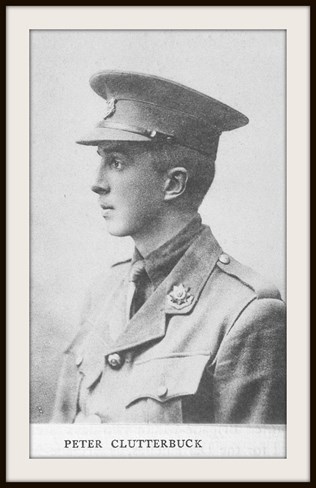
Above: 2nd Lieutenant Peter Clutterbuck
In 'B' Coy, Lieutenant B.S.C. Hutchinson was also killed on 20 September. Captain P.B. Maxwell died of his wounds on 24 September. ‘Pat’ Maxwell was one of the most promising officers in the East Yorkshire Regiment. He passed first out of Sandhurst in 1900, ‘being awarded the Queen Victoria Gold Medal, the Sword of Honour, and field glasses for proficiency in tactics’.
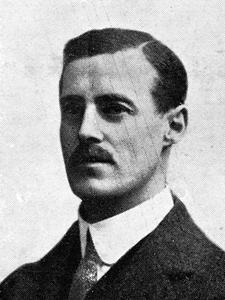
Above: Captain Peter ('Pat') Maxwell
He had combat experience on the North West Frontier of India during his service with the 35th Sikhs. He passed staff college in December 1913 in a cohort that included E.H.L. ‘Moses’ Beddington, L.E.O. Charlton, J.K. Dick-Cunyngham, H.C.T. Dowding, C.H. Foot, C.P. ‘Guffin’ Heywood, R.F.A. Hobbs, H. Karslake, G.H.N. Jackson, A.E. McNamara, E.N. Tandy and G.A. Weir, who went on to have significant careers during the Great War, and – in the case of Hugh Dowding – beyond. Trained staff officers were small in number in the British Army and their abilities at a premium. Losing one during the first clash of battle looks like carelessness. In “C” Coy, Lieutenant T.R. Bottomley was killed on 23 September, Captain B. Lawrence and Lieutenant H.S.F. Cosens on 27 October.
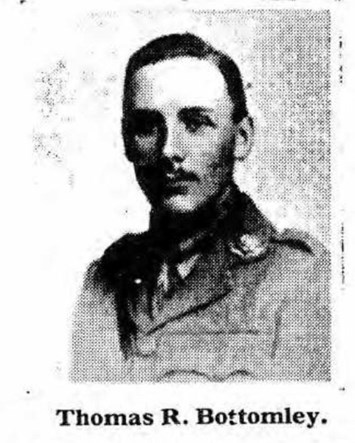
Above: Lieutenant T.R. Bottomley
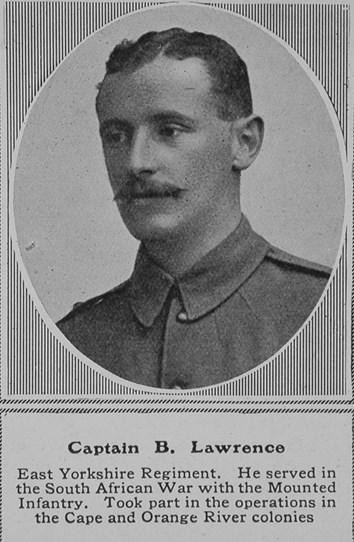
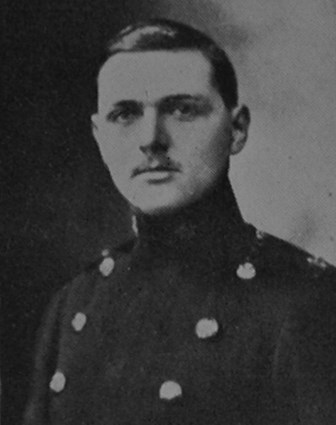
Above: Lieutenant Harold Cosens
The OC 'C' Coy, Captain Bogle, and 2nd Lieutenant Robson were both wounded. In 'D' Coy, 2nd Lieutenant M.R. Pease was killed on 20 October and Captain F. Hind died of his wounds on 29 October. Of 'D' Coy’s original complement of officers only Lieutenant V.E. Inglefield survived the war.
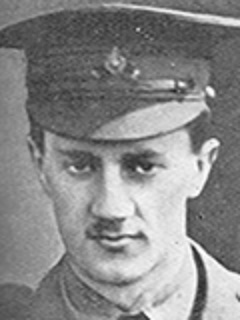
Above: 2nd Lieutenant Mark Pease
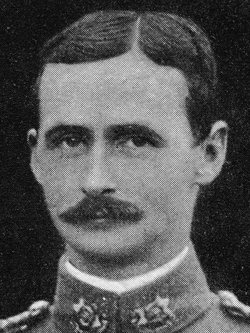
Above: Captain Frank Hind
6th Division was not heavily engaged in 1915, but the usual round of trench warfare continued to take its toll of the 1914 Regulars. 2nd Lieutenant R.T.F. Scott was killed on 16 March 1915.[17] Lieutenants J.A. Markham and F.H. Sasse died of their wounds, Markham on 7 May 1915 and Sasse on 8 May 1915. Thus, within less than ten months from the declaration of war, 1st Battalion East Yorkshire Regiment had lost sixteen of its original twenty-five officers, including its CO.[18]
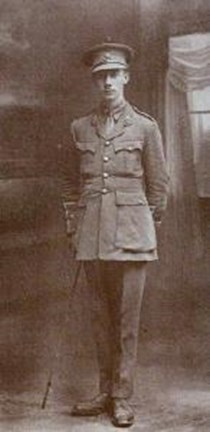
Above: 2nd Lieutenant (later Lieutenant) Richard Scott
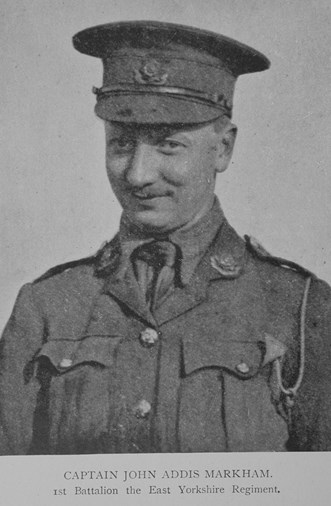
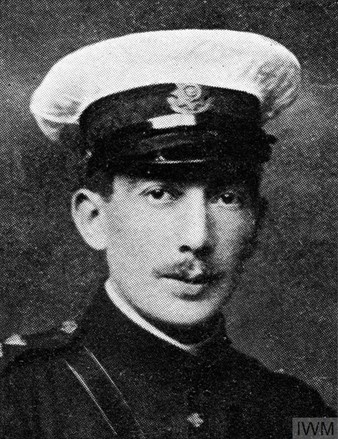
Above: Lt Frederick Sasse
Overall, as Peter Hodgkinson has pointed out, ‘83 percent of [1st East Yorkshire’s] company officers who arrived in France had become casualties’.[19] It is difficult to disagree with Spencer Jones’s conclusion that the fighting of 1914 ‘had torn the heart’ from the pre-war Regular officer corps.[20]
The impact of combat was just as devastating on the 2nd Battalion as it was on the 1st. By the end of February five officers had been killed, including the OCs “A”, “B” and “C” Coys, and five wounded, including the Adjutant. 2nd Lieutenant Addyman was killed on 4 February by the same shell that wounded his company commander, Captain Wilkinson, who died the following day. Captain Warren-Swettenham was killed on 6 February. Captain Hill was killed on 17 February.
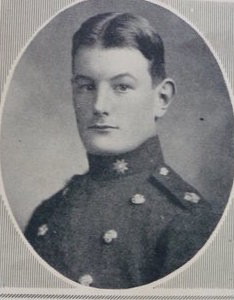
Above: 2nd Lieutenant (later Lieutenant) Oscar James Addyman
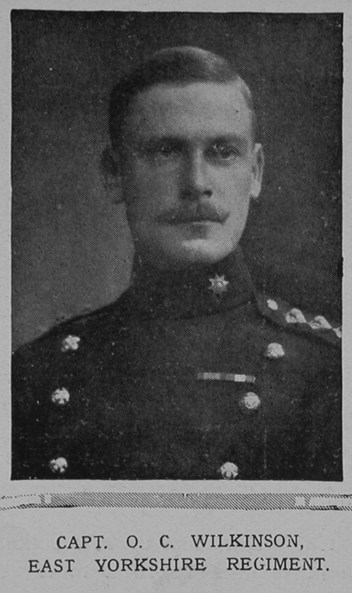
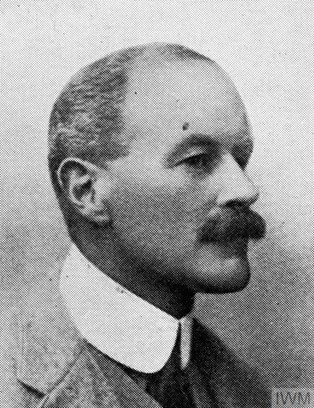
Above: Major Thomas Robert Eaton Wybault Warren-Swettenham
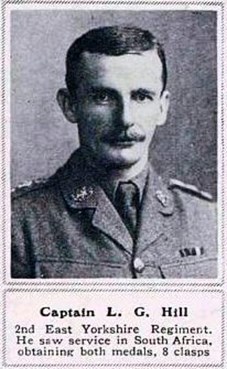
By the end of April the number of officers killed had risen to eleven, with seventeen wounded and one missing. The fatalities included two more ‘originals’, Captain Woodmass, killed on 23 April, and Lieutenant Ottley, killed on 22 May 1915.
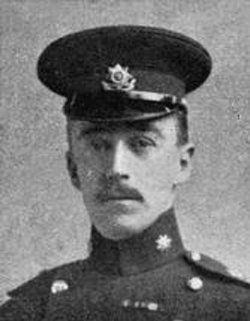
Above: Captain Kenrick Talbot Woodmass
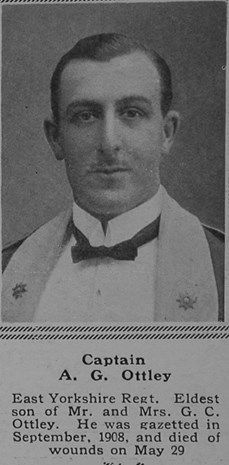
The War Diary listed the battalion’s officers on 30 June 1915. None of them was a 2nd Battalion officer from the August 1914 Army List: eight of the twenty-five officers named were not even East Yorkshires. A further two ‘originals’ were killed later in 1915, 2nd Lieutenant Prichard on 9 August and 2nd Lieutenant Wilson on 29 September. A further three were killed later in the war, Lieutenant Cart de Lafontaine on 9 July 1916, 2nd Lieutenant Kennard on 14 July 1916 and Lieutenant Saunders on 30 March 1918,[21] bringing the total number of fatalities from the original twenty-six officers to eleven.
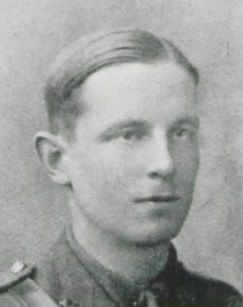
Above: 2nd Lieutenant Frederic Prichard
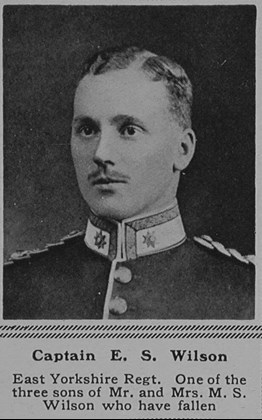
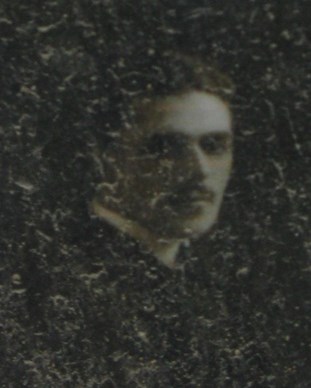
Above: Lieutenant Cart de Lafontaine

Above: Lieutenant (later Major) Harold Cecil Richard (‘Sam’) Saunders DSO
Professional Opportunity?
Richard Holmes once said to me that ‘all you needed to do to become a brigade commander in the BEF at the end of the war was to have been a Regular subaltern in August 1914 and still be alive’. When I tested this statement, it turned out not to be quite true. The principal start rank of the BEF’s brigade commanders at the end of the war was actually Captain. But Richard was right in essence, if not in fact. His statement captures not only the damaging early impact of the war on the Regular officer corps but also the professional opportunities it opened up for those fortunate enough to have survived. How well did the surviving Regular officers of the East Yorkshire Regiment fare in the professional opportunity stakes? The answer is not especially well.
Infantry battalion command was, perhaps, not the best starting point for a successful career during the war.[22] The toll of COs was high. According to Peter Hodgkinson, ‘by the end of 1914, 18 of the Regular COs of August 1914 were dead, 24 had been wounded, and 10 had been invalided … five were prisoners of war, two had been lost through court martial, and six others replaced’.[23] 1915 was little better. In 2nd East Yorkshire’s parent division, the 28th, 10 infantry battalion COs were killed, 11 wounded, 6 invalided and one made prisoner of war. Others were replaced. One of these was Colonel Sweetman, who may be said to have fallen at the first fence in the promotion stakes. Only five weeks after assembling with 28th Division’s other battalions at Winchester, 2nd East Yorkshire found themselves, on 1-3 February 1915, holding very rudimentary and inadequate trenches near Hill 60, south of Ypres, in appalling weather. On 4 February 83 Brigade had a trench blown in and lost to the Germans.[24] Attempts to retake it were poorly organised. Colonel Sweetman paid the price. He was sent home, never to hold a combat command again.
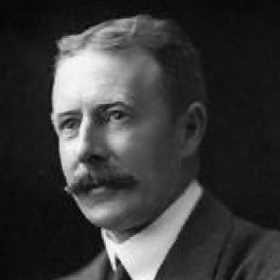
Above: Lieutenant-Colonel Michael James Sweetman
Of the Regiment’s eight Regular Majors only three survived the early fighting unscathed, Clarke, Young and Powell. Clarke’s career was the most successful. After commanding the 1st Battalion from 20 November 1914 until 17 March 1916, he was promoted to Brigadier-General. His two periods as GOC 52 Brigade, 17th (Northern) Division (18 March-20 November 1916 and 23 March-1 June 1917) were interspersed with a brief command of 3 Brigade, 1st Division (15-21 March 1917). He ended the war as GOC 43 Indian Infantry Brigade, Lahore. He retired in 1925 as a Lieutenant-Colonel (only one step up from the rank he would probably have obtained fairly soon had the war not occurred), but with the title of ‘Hon. Brigadier-General’. He was made CMG in 1916.
Major Young succeeded to command of the 1st Battalion after the death of Colonel Benson. He commanded 1st East Yorkshire until 10 November 1914, when Major Armstrong was brought in from the 2nd Battalion as CO. This looks very much like a vote of no confidence in Young. When he returned to a battalion command, it was as CO of the 2nd East Yorkshire (15 May 1915-8 June 1915). He was the battalion’s third ‘permanent’ CO. His third – and final - command was an external appointment as CO 2nd Battalion Yorkshire Regiment, 21 Brigade, 7th Division (later 30th Division). His first period (8 July 1915-30 Nov 1915) was ended by a wound. He returned on 5 December 1915 and remained in command until 1 October 1916, when he was invalided home.
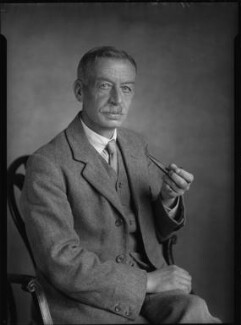
Above: Major Walter Herbert Young (died 1940)
Young was an infantry battalion commander for 521 days, a far from contemptible achievement in what was a very demanding job. He was gazetted DSO on 1 January 1917 and three times mentioned in despatches. He retired with the rank of Lieutenant-Colonel on 18 June 1919.
Major Powell ended the war as he began it - ‘Major, East Yorkshire Regiment’. He had two brief periods as Acting CO 2nd East Yorkshire (8 February 1915-9 February 1915 and 23 April 1915-8 May 1915). His second spell was ended by a wound. He appears to have spent the rest of the war as a Staff officer (GSO2, a Major-level appointment). The November 1918 Army List shows him as employed at the War Office.
The Captains of August 1914 fared especially badly in the early fighting. Eight of the twenty were dead by April 1915, including six of the original eight company commanders. The officer who had the longest and most successful career was the 1st Battalion’s Adjutant, Captain D.F. Anderson.
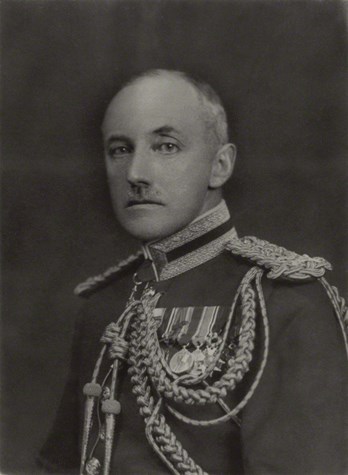
Above Captain Desmond Anderson
Having survived a wound on 20 September, his career eventually took the staff path. He was GSO3 V Corps (30 May 1915-9 February 1916), Brigade Major, 36 Brigade, 12th (Eastern) Division (10 February 1916-14 January 1917), GSO2 8th Division (15 January 1917-18 July 1917), GSO2 War Office (19 July 1917-22 February 1918), and GSO1 (chief of staff)in the reconstituted 25th Division (6 August 1918-22 April 1919). He continued in the army after the war, passed staff college, commanded the 1st East Yorkshire and rose steadily through a series of staff appointments. The outbreak of the Second World War found him MGGS Home Forces, in charge of Administration, Eastern Command. After a brief period of divisional command (45th and 46th Divisions) and a spell as Assistant Chief of the Imperial General Staff, he was promoted in December 1940to command III Corps, part of Persia and Iraq Command, with the rank of Lieutenant-General. He transferred to II Corps in 1943 and retired in 1944.
Six of the East Yorkshire’s surviving captains commanded battalions at some point during the war. Captain Trimble held four battalion commands: 11th East Yorkshire, 17 August-16 November 1916; 9th Norfolk, 27 January 1917-26 February 1917; 1/5th Leicestershire, 23 April-27 November 1917;and 1st East Yorkshire, 28 November 1917-8 April 1918, a total of 470 days of infantry battalion command. On 22 March 1918, the second day of the German Spring Offensive, he organised a stubborn defence of the village of Saulcourt, allowing 110 Brigade to retreat, before withdrawing to positions near Longavesnes.[25] By the time they got back to the Canal du Nord the battalion was down to eight officers and 90 Other Ranks. His DSO was gazetted on 1 January 1918. He ended the war employed with the Machine Gun Corps. Captain Riall commanded 13th York & Lancaster (1st Barnsley Pals), 15 July -22 September 1916, and the 12th York & Lancaster (Sheffield City Battalion), 12 October 1916-8 May 1917, a total of 287 days. Captain Headlam was CO 10th East Yorkshire (1st Hull), 7 August 1917-13 April 1918 (249 days), ending the war as CO 4th (Reserve) Battalion Welsh Regiment.
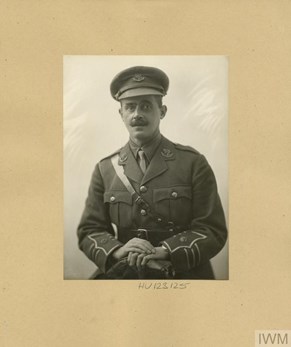
Above: Captain (later Lieutenant-Colonel) Thomas Alexander Headlam
Bogle, the only one of 1st Battalion’s original company commanders to survive the fighting of 1914, was CO 2nd East Yorkshire, 8 June 1915-7 September 1915 (91 days), but was not used again as a‘permanent’ battalion CO. He was A/CO 2ndNorthumberland Fusiliers, 8-12 October 1915, and ended the war as A/Major, 2nd East Yorkshire, attached 11th (Service) Battalion East Yorkshire (2nd Hull).Captain Cowper, after a brief period (9-23 August 1915) as Acting CO 6thEast Yorkshire (Pioneers)was ended by a shrapnel wound to his back that required evacuation to Britain, he returned as CO on 8 March 1916 and retained command until the end of the war.[26] The Armistice found him as Temporary Lieutenant-Colonel, substantive Major, one rank up from August 1914. Captain Hopkins went with the 2nd East Yorkshire to Salonika and remained there, eventually commanding the battalion as its seventh and final wartime CO.
Of the remaining captains of August 1914, Captain Harvey’s career took the staff path. Captain Berthon remained as Adjutant of the 3rd East Yorkshire until 17 February 1915, when he joined the 2nd Battalion. He ended the war as a Brevet Lieutenant-Colonel on the Staff. Captain Kino remained with the 3rd Battalion until 18 December 1914, when he joined the 1st Battalion. He was gazetted DSO on 23 June 1915 ‘for distinguished service in the field’, but spent part of 1915 in the Queen Alexandra Military Hospital, Millbank, suffering from rheumatism. He retired in the rank of Major with ill health on 24 July 1918 and died in 1924, aged only 43.
Captain Twiss remained at home when the 1st Battalion deployed, acting as Adjutant of the 10th (Service) Battalion, until 9 November 1914, he was then Adjutant 13th Battalion East Yorkshire Regiment (4th Hull), 10 November 1914-21 March 1917. After being attached 5thBuffs, 22 March 1917-5 October 1917, he spent the remainder of the war with the 7th Battalion East Yorkshire Regiment.
The outbreak of war found Captain Wrangham attached to the 3rd (Reserve) Battalion East Yorkshire. He was a staff officer (GSO3), 5 October-27 December 1914, before he joined his regiment. He ended the war as a substantive Major, attached to the 9th (Service) Battalion Worcestershire Regiment, which served in Mesopotamia and later with the North Persia Force. Major Wrangham served in India after the war and died there on 17 May 1920. He is buried at Peshawar.
Four of the August 1914 subalterns went on to command battalions during the war.[27] Lieutenant Bray was briefly CO 6th East Yorkshire (Pioneers) (23 Aug 1915-18 Oct 1915), an appointment that was terminated by illness. He was not again used as a commanding officer. He ended the war as substantive Captain (Brevet Major) on the Staff, having been appointed DAQMG on 15 March 1916. Lieutenant Stow was Adjutant of the Eastern Bengal Volunteer Rifles when the war broke out. He remained in this post until 30 June 1915. He deployed to France on 17 August 1915 and was attached to the 1st Battalion East Yorkshire. He assumed command of 1st East Yorkshire on 17 March 1916 and died of his wounds on 1 or 2 July 1916 at No. 34 Casualty Clearing Station.[28]
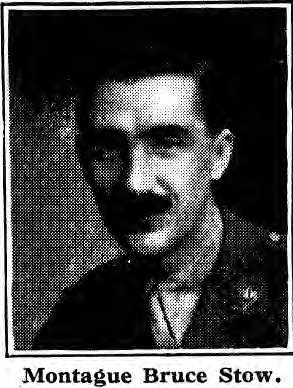
Lieutenant Saunders, a captain from October 1914, served in France with the 2nd Battalion, January-February 1915, when he was wounded and invalided home. He was appointed to command the Officers Training School at Tynemouth with the rank of T/Major. He returned to France, this time with the 1st Battalion, in October 1915, as 2 i/c. He became the sixth CO 1st East Yorkshire on 2 July 1916, at the age of 34, after A/Lieutenant-Colonel Stow was killed. He held the post until 2 November 1916 (123 days), a period that included much fighting on the Somme and at the end of which he was invalided home. He returned to 1st Battalion in February 1917, but only as 2 i/c to his successor as CO, A/Lieutenant-Colonel R.H. Waithman (Royal Sussex Regiment). Saunders was appointed Chief Instructor at II Corps School on 28 April 1917, followed by III Corps School in December 1917. He was killed in action on 30March 1918 while commanding a scratch battalion formed from the Schools to hold a section of line during the German Spring Offensive. Lieutenant Coles became the ninth CO 1st East Yorkshire on 8 April 1918, but was killed in action seventeen days later during the Second Battle of Kemmel Ridge while conducting a very determined defence of Onraet Wood, south of Ypres, where the 1st East Yorkshire held the German attack for several hours that morning. Only three officers and 34 Other Ranks managed to extricate themselves from the attack.
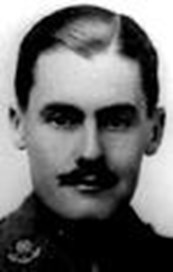
Above: Lieutenant (later Captain and T/Lieutenant-Colonel) James Hugh (‘Jim’) Coles
The BEF of September 1914 was ‘infantry heavy’. Infantry made up almost 58 per cent of the BEF’s total strength. By October 1918 the BEF’s infantry component had shrunk to just under a third of total strength. Branches of the army that had not existed on the outbreak of war came on stream, while others that had been small before the war grew exponentially. This meant the possibility of professional enhancement outside the regiment for the East Yorkshire’s young Regular officers. Chief among these opportunities were the Army Signal Service, the Machine Gun Corps and the Royal Flying Corps. Lieutenants Plimpton, Noel and Blacker found their niche in the Machine Gun Corps. Plimpton spent the whole of his active service in Salonika, ending the war on the staff of XII Corps with the rank of T/Lieutenant-Colonel. Lieutenants Hardiman and Mair and 2nd Lieutenant Smallwood served with the Army Signal Service.
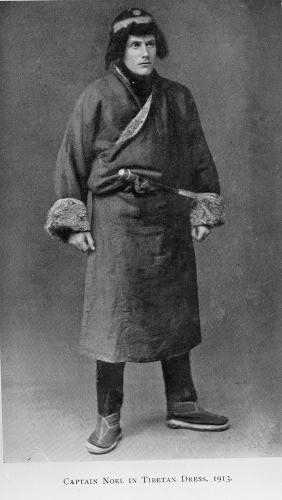
Above: Lieutenant (later Captain) Baptist Lucius Noel
Mair was on attachment to the Signal Service from 22 December 1913. He never served with the East Yorkshire Regiment after that date. He ended his career as a full Colonel in the Royal Signals (established in 1920). Smallwood was in career terms one of the East Yorkshire’s most successful Regular officers of August 1914, rising eventually to Major-General. He deployed to France in August 1914 as the 1st Battalion’s Transport Officer, but was seconded to the Army Signal Service on 25 November 1914. He remained with the Signal Service for the rest of the war, ending as a T/Major, substantive Captain. He passed staff college in 1923 and reverted to infantry employment, commanding 2ndEast Yorkshire, 1934-37. He spent much of the Second World War in East Africa, as Acting Commander 1st East African Division and commander of 23 Nigerian Brigade. He was promoted major-general in 1942 and became GOC Madagascar. His final appointment before retiring in 1946 was as Head of the Training Staff, Greek Army. He retired to Kenya and died there. Lieutenant Hartcup transferred to the Royal Flying Corps and eventually the Royal Air Force. He obtained his Royal Aero Club Aviator’s Certificate [No. 2068] at the Military School, Shoreham, on 26 November 1915, but his career in the RFC/RAF appears to have been administrative.
The remaining Regular subalterns of August 1914 had varied wartime careers. Broadley and Robson ended the war attached to the Colonial Office. Leadley-Brown was employed for most of the war as 2nd Ass. Supt. Ordnance Factories (3 September 1915-17 October 1916) and with the Ministry of Munitions (1 April 1917-1 November 1917). He went on half-pay on 25 December 1917, having apparently suffered health problems, possibly shell shock.
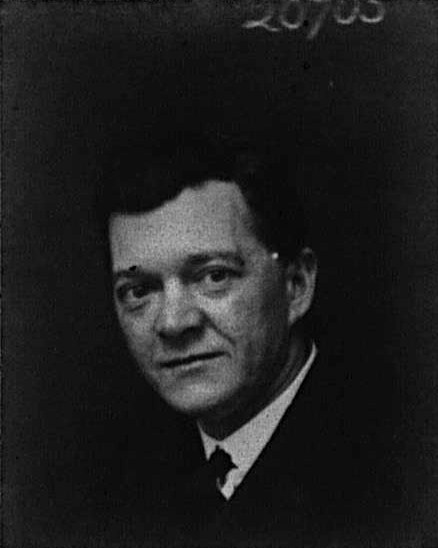
Above: Lieutenant (later Captain) Cuthbert Leadley-Brown
Grant, following service with 6th Battalion East Yorkshire Regiment, was attached to the Egyptian Army from 25 June 1916. Carruthers, who had been held back in August 1914 to help train the New Army battalions, became Adjutant of the 7th Battalion East Yorkshire Regiment and remained with it for the rest of the war. Browne served with the West African Regiment until 11 August 1916 and then with 1/4th Northamptonshire Regiment TF as T/Major (1916-17), ending the war as Captain (T/Major), 1st East Yorkshire.
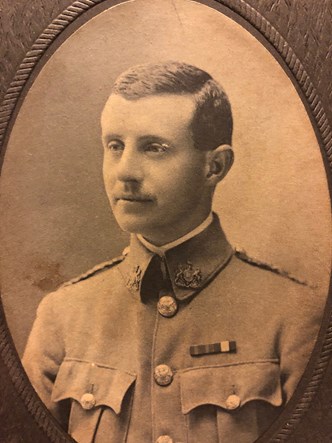
Above: Lieutenant W.S. Browne
Douglas spent much of the second half of the war employed with 7th Training Reserve Battalion. Willats was retained at home in August 1914 and attached to 6th East Yorkshire, with which he served on Gallipoli, being badly wounded. He was accidentally killed in a training accident at Rugeley Camp in Staffordshire on 17 December 1916, aged 22.[29]
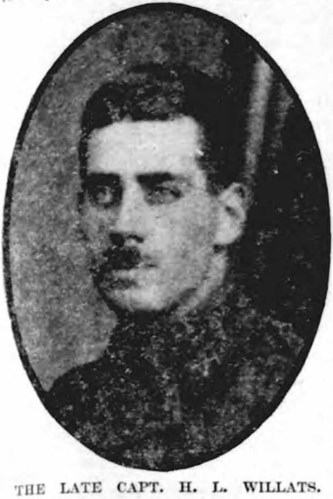
Wailes deployed to France with 2nd Battalion as its Adjutant. He was wounded (GSW and fractured arm) on 5 February 1915.After recovering, he seems to have spent the rest of the war as a Brigade Major. Porter ended his attachment to the West African Regiment on 5 October 1916. He spent the rest of the war with 1st Battalion East Yorkshire, ending in the rank of Captain.
In a totally unscientific comparison, I looked at the ‘career performance’ of Regular officers of the regiments that preceded and followed the East Yorkshire Regiment in the Army List, the West Yorkshire Regiment and the Bedfordshire Regiment. The comparison is not flattering to the East Yorkshire. Only one of the East Yorkshire’s Regular officers of August 1914 (J.L.J. Clarke) reached general officer rank during the war.
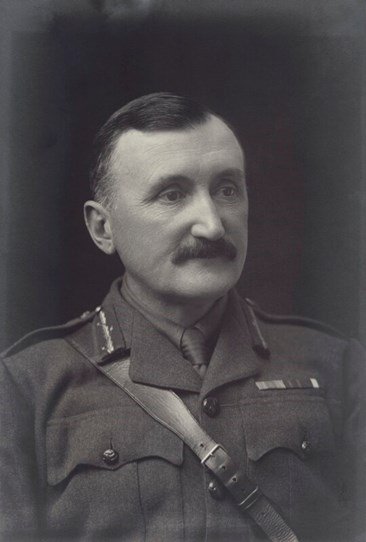
Above: Major (later Brigadier-General) John Louis Justice Clarke
The West Yorkshire Regiment produced six, four infantry brigade commanders[30] and two divisional commanders.[31] The Bedfordshire Regiment produced eight, five infantry brigade commanders,[32] an RFC Brigade commander,[33] a Corps chief logistics officer[34] and a divisional commander.[35] The greater career success of the Regular officers of the West Yorkshire and Bedfordshire Regiment is attributable to many reasons, not least chance, but what is apparent is the importance of having passed staff college, something in which the pre-war East Yorkshire Regiment may be thought under par.’
Few who have read this article could fail to be struck, indeed moved, by the impact of the losses on the British Army as an institution and on the officer corps as a social group. In researching and writing it, I did not expect to confront my fundamental view of Britain’s war, but it has made me do so.
‘But for the small British force ,’ wrote General Spears in 1930, ‘final and irremediable defeat would have overtaken France.’[36] I have always had doubts about this. The salvation of France in 1914 was secured by General J.J.C. Joffre. His decision to order the manoeuvre that resulted in the battle of the Marne was perhaps the decisive moment of the war in the west. It ensured that there would be no quick German victory and the German high command was always pessimistic about its ability to win a long war, especially a long war involving the British Empire. The BEF undoubtedly did useful work during the retreat from Mons by providing a speed bump on Germany’s ‘road to victory’, but it was always just behind the action on the Marne and even at 1st Ypres, the BEF’s greatest achievement, the French Army was predominant. Haldane created the BEF essentially as an economy measure and as a symbol of support for France. But he never intended it to be more than six infantry divisions and a cavalry division. Whether the French expected the BEF to make a military difference is doubtful, but they welcomed it as a symbol and guarantee of allied cohesion. Whether it could have contributed to allied cohesion by being employed elsewhere than on the Western Front is a moot point. Its use there certainly denied Britain’s carefully considered maritime strategy the military force that it required to be effective.[37] Perhaps this outcome was inevitable, perhaps it was necessary, as Kitchener argued, but it was also fateful, bringing about the kind of war that Britain had been so adept in the past at avoiding and tying British strategy and policy inexorably to France and its fate.
Prof JM Bourne
[I am pleased to acknowledge the help of the following in the research and writing of this article: Dr Derek Clayton, Jeremy Dandridge, Dr Peter Hodgkinson, Andy Johnson (‘The Sage of Tipton’), Dr Bill Mitchinson, Jill Stewart (WFA) and David Tattersfield (WFA). I am particularly grateful for Andy’s help in dealing with the Commonwealth War Graves Commission. The views expressed in the article are mine alone. I dedicate it to the memory of Peter Lawrence (1941-1999).]
John Bourne taught History at Birmingham University for thirty years before his retirement in September 2009. He founded the Centre for First World War Studies, of which he was Director from 2002 to 2009, as well as the MA in British First World War Studies. He has written widely on the British experience of the Great War on the war front and the home front. He is currently completing a multi-biography of Britain’s Western Front Generals. He is a Vice President of The Western Front Association, a Member of the British Commission for Military History, a Fellow of the Royal Historical Society and Hon. Professor of First World War Studies at the University of Wolverhampton.
Appendix
Biographical Index of the East Yorkshire Regiment’s Regular Officers of August 1914
Names shown in Bold are those of officers shown serving with the 1st or 2nd Battalions in the August 1914 Army List. Names shown in Italics are those of officers who were on extra-battalion or extra-regimental attachments, those who received Regular commissions in August 1914 after the start of the war, and those who were in the Special Reserve.
Lieutenant-Colonel Richard Erle Benson (1862-1914), CO 1st Battalion: b. London, 4 October 1862, youngest of four children and third son of General Henry Roxby Benson (1818-92) (late 17th Lancers), a veteran of the Crimean War and Indian Mutiny, and Mary Henrietta Wightman (1824-1920); m. (1894) (Janet) Florence Armour (1865-1954), daughter of Matthew Armour, cotton broker; 2d 1s; ed. Eton College; commissioned from the Militia14 May 1884; Adjutant 4th Battalion East Surrey Regiment, 5 April 1899-1904; CO 1st Battalion East Yorkshire Regiment, 15 August 1911-20 September 1914; wounded while leading an attack on 20 September 1914; died at the St Nazaire base hospital on 27 September, aged 51.[38] His body was repatriated. He is buried in Reynoldston (St George) Churchyard, Glamorgan. A Freemason. Probate: £17,042 17s 8d.
Lieutenant-Colonel Michael James Sweetman OBE (1865-1922), CO 2nd Battalion: b. Ferns, Co. Wexford, 31 March 1865, third of eight children of Walter Sweetman MA (1831-1905), Barrister-at-Law, and Mary Butler (1832-1914); m. (22 August 1907) Adelaide Mary Feilding (1872-1934); ed. RMC Sandhurst, commissioned 14 September 1887; ADC to GOC SE District, South Africa, 1 March 1896-11 November 1898; ADC to GOC South Africa, 12 November 1898-10 June 1899; South African War, 1900-1 (MiD); Adjutant 3rd Battalion Royal Irish Regiment, 16 August 1901-15 August 1904; CO 2nd Battalion East Yorkshire Regiment, 1 March 1914-8 February 1915; CO 14th(Reserve) Battalion Middlesex, 27 March 1915-31 August 1916; CO 24 Training Reserve Battalion, 1 September 1916-12 April 1917;employed with the Labour Corps, 13 April 1917-end of the war. MiD 18 December 1917 and 10 July 1919. He died at Clohamon House, Ferns, Co. Wexford on 24 September 1922, aged 57. The Sweetmans were a prominent Co. Wexford family. Probate: £2,843 16s 6d (in England).
Major (later Lieutenant-Colonel) William Herbert Armstrong (1867-1940), 2 i/c 2nd Battalion: b. Co. Roscommon, 5 (or 20) December 1867; commissioned 27 June 1888 after spending 2 years and 204 days in the ranks. North West Frontier: served Malakand Field Force, 1897-98, as Brigade Transport Officer, 4th Brigade. East Africa: OC 4th Somali Camel Corps, 16 July-2 November 1903; Special Service(as Transport Officer) Somaliland Field Force, 14 January 1904-27 May 1904. Adjutant Indian Volunteers, 30 December 1905-12 January 1906. CO 1st Battalion East Yorkshire Regiment, 11 November-19 November 1914 (w); after recovering from his wounds, he spent the rest of the war on ‘Instructional Duties’. He retired on 30 March 1919 as a Lieutenant-Colonel. Colonel Armstrong died in Bournemouth, on 11 May 1940, aged 73. Probate: £2,034 6s 10d.
Major (later Brigadier-General) John Louis Justice Clarke CMG psc FRGS (1870-1944), DAA&QMG, Eastern Command: b. South Stoneham, Hampshire, 23 November 1870, the son of Lieutenant-Colonel Alfred Frederick Stafford Clarke MD RAMC; m. Lilian Georgina O'Farrell (1879-1932), daughter of Sir George Joseph Plunkett O'Farrell MD JP (1845-1911), Commissioner of Control and Inspector of Lunatic Asylums, Ireland; ed. Wellington College and RMC Sandhurst, commissioned 30 January 1889; passed staff college in 1900 in a cohort whose course was truncated by the exigencies of the South African War, in which he was a Special Service Officer, later serving on the Staff (MiD). Further staff experience followed: DAAG Irish Command, June 1903-June 1906; GSO2 Western Command, July 1907-July 1911; DAA&QMG Eastern Command, June 1913-August 1914. CO 1st Battalion East Yorkshire Regiment, 20 November 1914-17 March 1916; GOC 52 Brigade, 18 March 1916-20 November 1916; and 23 March 1917-1 June 1917; GOC 3 Brigade, 15 March-21 March 1917; GOC 43 Indian Infantry Brigade, Lahore, September 1918-July 1919. MiD 1 January 1916, 15 June 1916 and 4 January 1918. He retired on 17 January 1925 as a Lieutenant-Colonel (Hon. Brigadier-General). He died in London on 3 January 1944, aged 73. Probate: £9,513 0s 6d.
Major Walter Herbert Young DSO (1870-1940), 2 i/c 1st Battalion: b. Southborough, Kent, 7 February 1870, fifth of six children of Major-General Charles Metcalfe Young RA (1826-1905) and Elizabeth Ann Chapman; m. (9 September 1897) Jeanie Marguerite Grace Bolden (1873-1955), daughter of George Bolden, merchant; 1s 2d; ed. United Services College and RMC Sandhurst, commissioned 23 March 1889; South African War, 1900-2 (MiD); Adjutant 2nd East Yorkshire, 20 June 1900-19 June 1904; Adjutant 3rd (Reserve) Battalion East Yorkshire, 9 December 1904-December 1908; CO 1stEast Yorkshire, 20 September 1914-10 November 1914; CO 2ndEast Yorkshire, 15 May 1915-8 June 1915; CO 2ndYorkshire Regiment, 8 July 1915-30 November 1915 (w); 5 December 1915-1 October 1916 (inv); i/c Training Reserve Battalion, 1 April-31 August 1917. He ended the war as substantive Lieutenant-Colonel, Yorkshire Regiment, employed 277 Training Reserve Battalion, 1 September 1917-end of the war. MiD 17 February 1915, 15 June 1916 and 4 January 1917; DSO 1 January 1917. Retired as a Lieutenant-Colonel on 18 June 1919. He died at Farnham, Surrey, on 12 April 1940, aged 70. Probate: £10,458 5s 0d.
Major Harold Haines Powell OBE (1868-1949), 2nd Battalion: b. Birmingham, 19 October 1868, youngest of four children and second son of Thomas Powell (1826-98), a gentleman of independent means, and Elizabeth ('Eliza') Haines; m. (1899) Margaret Jane Crampton (1873-1964), daughter of Philip Crampton, physician; 1d; ed. RMC Sandhurst, commissioned 4 September 1889; Adjutant 1st Sutherland Volunteer Rifles, 1 August 1899-21 July 1901; A/CO 2ndEast Yorkshire, 8 February 1915-9 February 1915; 23 April 1915-8 May 1915; subsequently on the Staff (GSO2, 13 September 1915), attached to the War Office. He ended the war as he began it, Major, 2nd East Yorkshire Regiment. He died at Woking on 25 April 1949, aged 80. Probate: £9,776 18s 0d.
Major Henry Glanville Allen Moore (1865-1915), 1st Battalion, attached 3rd Battalion, commanding Depot: b. Misterton, Nottinghamshire, 6 November 1865, eldest child and only son of Rev. Henry Dawson Moore (1829-94), Vicar of Misterton, and Harriet Louisa Richards; m. (3 June 1893) Julia Margaret Parry-Okenden (1866-1929); 2d; ed. Rossall School; enlisted in the Grenadier Guards (1886), discharged to a commission in the Royal Warwickshire Regiment 2 September 1891, transferring to the East Yorkshire Regiment 8 July 1908; served in the Egypt Campaign (1898); OC East Yorkshire Regiment Depot, Victoria Barracks, Beverley, 21 February 1909-18 August 1914; CO 6th (Service) Battalion East Yorkshire Regiment (Pioneers), 19 August 1914-9 August 1915; died as the result of a bayonet wound at Suvla Bay, 9 August 1915, aged 49. He is buried in Greenhill Cemetery (Gallipoli), Turkey. Probate: £138 12s 0d.
Major Thomas Robert Eaton Wybault Warren-Swettenham (1867-1915), OC “A” Coy, 2nd Battalion: b. Cheltenham, 10 October 1867, the elder son of a Cheshire country gentleman, Robert Warren-Swettenham (1838-1902), of Swettenham Hall, near Congleton, and Amelia Marion Wybault (1845-1927); m. (1907) Emmete Florence Cope (1880-1932), daughter of Edward Stephens Cope (1852-1924), brassfounder (Birmingham and London); 1s; ed. RMC Sandhurst, commissioned 16 March 1889; killed in action on 6 February 1915, aged 47, during 2nd Battalion’s first clash of battle. Major Warren-Swettenham has no known grave; he is commemorated on the Ypres (Menin Gate) Memorial, Belgium. Probate: £37,973 0s 0d.
Major Walter Ernest Campion (1871-1914), OC “A” Coy, 1st Battalion: b. Dean, Bedfordshire, 9 August 1871, fifth of eleven children of a farmer, Henry Campion 1836-1922), of Bletsoe Castle, and Eleanor Ann Campion (1843-91); unmarried; ed. Bedford Modern School; commissioned from the Militia12 December 1894; served in the South African War, 1900-2, with 5th Mounted Infantry (MiD); a keen horseman, who won the Army cup in 1910; OC “A” Coy, August 1914, killed in action28 October 1914, near Armentières, aged 43. Major Campion is buried in Ration Farm Military Cemetery, France, and commemorated on the Bedford Modern School Roll of Honour. A Freemason. Probate: £1,278 2s 11d.
Major Walter Nathaniel Pike (1872-1954), OC “D” Coy, 2nd Battalion: b. Bromyard, Herefordshire, 13 October 1872, third of nine children of Francis Pike (1831-1918), late Captain 86th Regiment, and Annie Blyth (1841-1912); unmarried; ed. RMC Sandhurst, commissioned in the Black Watch 21 January 1893, transferring to the East Yorkshire Regiment 13 October 1897; Stn. Staff Officer, 1st Class India, 14 June 1902-31 May 1904; BM India/DAAG Southern District, India, 1 June 1904-13 June 1907; OC “D” Coy, 2nd East Yorkshire, January 1915; employed 5th (Flintshire) Battalion Royal Welsh Fusiliers TF, 31 May 1916-January 1918, 7th (Service) Battalion East Yorkshire Regiment and 4th Battalion East Yorkshire Regiment TF. His younger brother, Colonel Geoffrey Davies Pike MC (1880-1918), 9th Gurkha Rifles, was murdered by Bolsheviks in North Ossetia, 18 August 1918. Major Pike died at Bideford, Devon, on 7 February 1954, aged 81. Probate: £21,528 8s 5d.
Captain (later Lieutenant-Colonel) Benjamin William Bogle (1875-1933), OC “C” Coy, 1st Battalion: b. Shorncliffe, Kent, 18 October 1875, fourth of nine children of Colonel John du Terreau Bogle RE (1845-1917) and Blanche Eleanora Bourchier Savile (1845-1932); m. Mary Frances Brandt (1878-1961), daughter of Rev. Herbert Brandt (1837-1918); 1d 1s; ed. Charterhouse; commissioned from the Militia7 December 1895; South African War, 1900-2, with 2nd Battalion East Yorkshire Regiment; Adjutant 1stEast Yorkshire, 30 July 1905-29 July 1909; Adjutant 6th Battalion North Staffordshire Regiment TF, 10 May 1910-9 May 1913; OC “C” Coy, 1st East Yorkshire, August 1914; CO 2nd East Yorkshire, 8 June-7 September 1915; A/CO 2nd Battalion Northumberland Fusiliers, 8-12 October 1915; ended the war as A/Major, 2nd East Yorkshire, attached 11th (Service) Battalion East Yorkshire (2nd Hull). MiD 17 February 1915. He had two brothers in the Indian Army. Colonel Pike died at Topsham, Devon, on 7 August 1933, aged 57. Probate: £1,366 18s 11d.
Captain Arthur Henry Wilson (1875-1914), OC “D” Coy, 1st Battalion: b. Nashik, Bombay, India, 5 July 1875, the son of Colonel W.H. Wilson and Minnie Gordon; unmarried; commissioned from the Militia9 December 1896; South African War, 1900-1, with 2nd Battalion East Yorkshire Regiment (Adjutant, 14 March-9 May 1900) and 5th Mounted Infantry; Adjutant 2nd East Yorkshire, 20 June 1907-30 March 1910; OC “D” Coy, August 1914, killed in action, near Armentières, 18 October 1914, aged 39. Captain Wilson has no known grave; he is commemorated on the Ploegsteert Memorial, Belgium. Probate: £1,331 19s 11d.
Captain Eric Lea Priestley Edwards (1877-1914), OC “B” Coy, 1st Battalion: b. Scarborough, North Riding of Yorkshire, 2 March 1877, the son of Lea Priestley Edwards (1845-1922), gentleman, of Warberry Court, a handsome Victorian villa on the ‘English Riviera’, and late Lieutenant 2nd West Yorkshire Yeomanry Cavalry, and Emily Gertrude Edwards (1846-1919), daughter of Sir Henry Edwards Bt. MP (1812-86), Masonic Provincial Grand Master of West Yorkshire; unmarried; ed. Harrow School and RMC Sandhurst, commissioned 20 February 1897; served on the North West Frontier in the Tirah Expedition, 1897-8, attached to the Northamptonshire Regiment; Adjutant 5th Battalion Yorkshire Regiment, 27 July 1907-26 July 1910; OC “B” Coy, August 1914, killed in action on the Aisne at the head of his men, 20 September 1914, aged 37. Captain Edwards has no known grave; he is commemorated on the La Ferté-sous-Jouarre Memorial, France, and on the Harrow School Roll of Honour. Probate: £100 0s 0d.
Captain (later Lieutenant-Colonel) Thomas Alexander Headlam (1875-1953), Instructor School of Musketry, India: b. Barton-upon-Irwell, Lancashire, 5 April 1875, son of Sir Francis John Headlam MA JP (1829-1908), Barrister-at-Law and Stipendiary Magistrate of Manchester, and Matilda Ann Pincoff (1847-1921); m. (1917) Esther Winifred Dalrymple-Horn-Elphinstone (1877-1960), daughter of Sir Graeme Hepburn Dalrymple-Horn-Elphinstone4th Bt. (1841-1900); ed. Wellington College and Trinity College, Cambridge; commissioned from the Militia 15 May 1897; Adjutant 1st East Yorkshire, 30 July 1899-29 July 1903; Instructor (GSO3) School of Musketry, India, 3 March 1911-1916; Mesopotamia, 5 June 1916-30 November 1916;CO 10th (Service) Battalion East Yorkshire Regiment (1st Hull), 7 August 1917-13 April 1918; ended the war as CO 4th Battalion Welsh Regiment TF; he remained in the army after the war and commanded the 1st Battalion East Yorkshire Regiment, November 1919-November 1923. MiD 23 May 1918. He retired on 4 June 1924. Brigadier-General H.R. (‘Hugo’) Headlam CMG DSO psc (1877-1955), long serving commander of 64 Brigade, which included 1st East Yorkshire, was his younger brother. Colonel Headlam died at West Bay, Dorset, on 19 January 1953, aged 76. Probate: £4,627 7s 0d.
Captain (later Colonel) Charles Peter Berthon OBE (1875-1942), Adjutant, 3rd (Reserve) Battalion East Yorkshire Regiment: b. Southsea, Hampshire, 18 October 1875, eighth of nine children of Major-General Thomas Porter Berthon (1835-1912) and Amelia Caroline Hurd Miles (1846-86); m.1 (3 December 1905) Angela Louise Black (1884-1967); 1s 3d; m.2 (1920) Ruth Euphemia Meldrum Ferrier (1899-1978); 1s; commissioned from the Militia 24 March 1897; ADC to Governor and C-in-C Barbados, 6 February 1901-28 March 1902; Adjutant 2nd Battalion, 20 June 1904-19 June 1907; Adjutant 3rd (Reserve) Battalion East Yorkshire Regiment, 10 October 1911-17 February 1915: joined 2nd Battalion in France, 22 February 1915 (wounded). Ended the war as a Major, Brevet Lieutenant-Colonel, on the Staff. MiD 22 June 1915 and 1 January 1916. Colonel Berthon died in Lymington and District Hospital, Hampshire, on 23 September 1942, aged 66. His son by his second marriage was Vice-Admiral Sir Stephen Ferrier Berthon RN (1922-2007). Probate: £4,666 19s 3d.
Captain (later Major) Edward Francis Twiss (1876-1944), 2nd Battalion, attached 3rd (Reserve) Battalion: b. Anlaby, East Riding of Yorkshire, 16 September 1876, oldest of four children of Edward Curtis Twiss (1844-1901), Barrister-at-Law and Police Magistrate, and Fanny Maria Penrose Ringrose (1849-1919); m. Frances Parke Butler Ewens (1898-1979), daughter of John Ewens, civil engineer of St Louis, Missouri; 1d 1s; commissioned from the Militia 5 January 1898; Adjutant 10th (Service) Battalion East Yorkshire Regiment (1st Hull), 8 September 1914-9 November 1914; Adjutant 13th Battalion East Yorkshire Regiment (4th Hull), 10 November 1914-21 March 1917; attached 5thBuffs, 22 March 1917-5 October 1917; spent the remainder of the war with the 7th Battalion East Yorkshire Regiment. His brother Captain Arthur Montague Twiss (1881-1914), RE (attached 3 Sappers and Miners) was killed in action on 17 November 1914; another brother, Captain (T/Lieutenant-Colonel) Clifford Charles Horace Twiss (1879-1947) DSO BA, late Indian Educational Service, volunteered in August 1914 and was the first Adjutant 12th (Service) Battalion East Yorkshire Regiment (3rd Hull), later commanding the 13th (Service) Battalion East Yorkshire Regiment (4th Hull), 17 September 1917-8 February 1918 and the 15th (Service) Battalion West Yorkshire Regiment (1st Leeds), 15 March 1918-27 March 1918, when he was captured during the German Spring Offensive. Major Twiss died in 1944, aged 68.
Captain Bertram Lawrence (1876-1914), “C” Coy, 1st Battalion: b. Bayswater, London, 24 December 1876, the son of Dr Henry Cripps Lawrence (1841-1919), medical practitioner, and Mary Charlotte Smith (1851-1933); m. (1912) Eleanor Mary Smyth (1887-1972), daughter of Major-General James Gibbons Smyth (1837-1914); ed. Tideswell Endowed Grammar School, Malvern College and RMC Sandhurst, commissioned 16 February 1898;Adjutant 1st Battalion, 30 July 1903-29 July 1905; Adjutant Discharge Depot, Fort Brockhurst, 1909-13, Gosport, Hampshire; OC “C” Coy, 1st Battalion, August 1914; killed in action on 28 October 1914, reportedly shot by a sniper while leading his men in an attack to recapture a lost trench, aged 37. Captain Lawrence is buried in Ration Farm Military Cemetery, France, and commemorated on the Malvern College Roll of Honour. He was the grandson of Major-General Henry Lawrence (1791-1887), Indian Army. Probate: £581 11s 7d.
Captain Osborn Cecil Wilkinson (1877-1915), OC “C” Coy, 2nd Battalion: b. Simla, India, 8 September 1877, youngest of six children of Hon. Major-General George Allix Wilkinson RA psc (1829-1919), and Eliza Gosling (1836-1910); m. Esme Barbara Wilson (1887-1967), daughter of Alexander Wilson (1843-1907), East India Merchant; 1s; ed. RMC Sandhurst, commissioned 16 February 1898; South African War, 1900-1, with 2nd Battalion East Yorkshire Regiment; Adjutant 3rd (Reserve) Battalion East Yorkshire Regiment, 10 October 1908-9 October 1911; OC “C” Coy, 2nd East Yorkshire, January 1915; he died of wounds on 5 February 1915, aged 37. Captain Wilkinson is buried in Hazebrouck Communal Cemetery, France. Probate: £553 1s 4d.
Captain (later Lieutenant-Colonel) Francis Henry Harvey CMG DSO psc(1878-1960), at Staff College: b. Kohat on the North West Frontier, 9 November 1878, younger son of Lieutenant-Colonel Edward Harvey RE (1839-1919) and Rosa Marion Moncton Turnbull (1855-1917); m. (31 May 1904) Arabella Lucy Bethia Jackson (1877-1954), daughter of Captain Charles Henry Jackson (1838-1905); 1s; ed. RMC Sandhurst, commissioned in the Border Regiment 3 August 1898, transferring to the Indian Army 27 February 1903 and then to the East Yorkshire Regiment 4 April 1908. He served in the South African War, 1899-1901, as Assistant Adjutant of the Depot Battalion, and in operations with 1st Battalion Border Regiment. During the Great War, he was successively GSO3 2nd/1st London Division, 8th Division and the Central Force Home Defence, 5 August 1914-11 May 1915; GSO3 30thDivision, 12 May-30 January 1916; GSO2 18th (Eastern) Division, 31 January 1916-29 November 1916; GSO2 Fifth Army, 30 November 1916-30 January 1917; GSO1 Fifth/Fourth Armies, 31 January 1917-3 April 1918; GSO1 Reserve Army British Armies in France, 4 April 1918-22 May 1918; GSO1 Fifth Army, 23 May 1918-20 September 1918. He ended the war as GSO1 Vladivostock (from 18 October 1918). DSO 1 January 1917; MiD 4 January 1917, 11 December 1917 and 20 May 1918. He made Brevet Lieutenant-Colonel on 3 June 1918 and substantive Lieutenant-Colonel on 11 November 1920, retiring on 27 May 1925. Colonel Harvey died in Malta in 1960, aged 82.
Captain (later Major and A/Lieutenant-Colonel) Claud Phineas Bookey Riall (1876-1952), 2nd Battalion: b. Bray, Co. Wicklow, 2 March 1876, the son of Commander Arthur George Roberts Riall RN (1842-1915) and Selina Florinda Bookey; m. (1915) Ida Margaret Clare Ryder (1893-1954), daughter of Colonel Charles Henry Dudley Ryder RE (1868-1945); 1d 1s; ed. Charterhouse; commissioned from the Militia4 May 1898; served in South African War (1902) with 2nd Battalion East Yorkshire Regiment, and in Burma and India; Adjutant 2nd East Yorkshire, 31 March 1910-30 March 1913; Adjutant11thEast Yorkshire (2nd Hull), 7 September 1914-31 August 1915; CO 13thYork and Lancaster Regiment (1st Barnsley) , 15 July 1916-22 September 1916; CO 12th (Service) Battalion York and Lancaster Regiment (Sheffield City Battalion), 12 October 1916-8 May 1917; employed 238 Training Reserve Battalion, 3 October 1917-31 October 1917. MiD 4 January 1917. Major Riall died at Killiney, Co. Dublin on 10 June 1952, aged 76. The Rialls were a military family. His younger brothers, Major Malcolm Brown Bookey Riall (1879-1968), West Yorkshire Regiment, and Captain (later Lieutenant-Colonel) Bertram Charles Riall (1881-1953), Leinster Regiment, were also Regular soldiers. Probate: £23,289 19s 1d (in England).
Captain Algernon Roderick Kino DSO (1880-1924), 1st Battalion, attached 3rd (Reserve) Battalion: b. Canonbury, London, 17 June 1880, sixth child of Gustavus Adolphus Kino (1837-1909), merchant tailor, and Laura Kino (1838-1912); married; ed. Dulwich College and RMC Sandhurst, commissioned 21 February 1900; hospitalised (Queen Alexandra’s Military Hospital) with rheumatism (1915); retired from the army with ill-health, 24 July 1918. DSO 23 June 1915. Captain Kino died at Ealing on 10 February 1924, aged 43. He is commemorated in the British Jewry Book of Honour. Probate: £1,072 7s 9d.
Captain (later Lieutenant-General Sir) Desmond Francis Anderson KBE CB CMG DSO (1885-1967), Adjutant, 1st Battalion: b. Dunham Massey, Cheshire, 5 July 1885, only son of Frank Herbert Anderson (1856-1900), civil engineer, and Eleanor Mabel Atkinson (1861-1939); m. (1915) Mary Hope Prisca Wilkin(1894-1984), daughter of Rev. Sydney William Wentworth Wilkin (1859-1927), Chaplain to the Forces during the Great War; ed. Rugby School and RMC Sandhurst, commissioned 28 January 1905 in the Devonshire Regiment, transferring to the East Yorkshire Regiment28 August 1910; Adjutant 1st East Yorkshire, 20 July 1912-29 May 1915; wounded 20 September 1914; BM 36 Brigade, 10 February 1916-14 January 1917; GSO2 8th Division, 15 January 1917-18 July 1917; GSO2 War Office, 19 July 1917-22 February 1918; GSO1 (T/Lieutenant-Colonel), 25th Division, 5 August 1918-22 April 1919. MiD 17 February 1915, 1 January 1916, 4 January 1916 and 5 July 1919; DSO 18 February 1915. Post War: passed staff college, 1922; CO 1st East Yorkshire, 1927-31; AQMG, 1932-33; Deputy Director of Military Operations & Intelligence, 1932-36; Deputy Director of Military Intelligence, 1936-38; Major-General i/c Administration, Eastern Command, 1938-39; MGGS Home Forces, 1939-40; GOC 45th (Wessex) Division (UK), February-May 1940; Assistant CIGS, May-July 1940; GOC 46th Division, July-December 1940; GOC III Corps, December 1940-1943; GOC II Corps, 1943-44. Retired 15 May 1944. Colonel of the East Yorkshire Regiment, 1940-48. General Anderson died at Chailey Green, Sussex, on 29 January 1967, aged 81. Probate: £25,299 0s 0d.
Captain Frank Hind (1879-1914), “D” Coy, 1st Battalion: b. Goole, East Riding of Yorkshire, 24 September 1879, ninth of eleven children of William Everatt Hind (1835-92), solicitor, and Mary Ann Maw (1843-98); m. (12 October 1911) Constance Evelyn Harrison (1885-1959); commissioned from the Militia 5 January 1901; he had considerable combat experience in the South African War, 1899-1901 (where he was wounded five times) and in Sierra Leone when on attachment to the West African Regiment. He died of his wounds as a Prisoner of War in a German field hospital on 29 October 1914, aged 34. Captain Hind is buried in Laventie Military Cemetery, France.
Captain (later Major) Darcy George Wrangham (1878-1920), 2nd Battalion, attached 3rd (Reserve) Battalion: b. Hotham, East Riding of Yorkshire, 29 October 1878, fifth and youngest child of Walter Francis Wrangham JP (1829-93), Barrister-at-Law and Police Magistrate,and Fanny Grimston (1840-1929); m. (1916) Jean V.M. Fitzpatrick; commissioned from the Militia14 February 1900; served in the South African War, 1900-2, with 2nd Battalion East Yorkshire Regiment; GSO3 Humber Defences, 5 August 1914-27 December 1914; attached 9th (Service) Battalion Worcestershire Regiment from August 1915 in Gallipoli, Mesopotamia and North Persia. He died ‘of fever’ in India on 22 July 1920, aged 41, and is buried at Peshawar [now in Pakistan]. Probate: £2,150 4s 11d.
Captain (later Lieutenant-Colonel) Malcolm Gordon Cowper DSO (1877-1931), 1st Battalion: b. Marylebone, London, 16 November 1877, fourth and youngest child of John Cowper, a gentleman of independent means, and Marian Caroline Emmott Green-Emmott (1841-95); m. Margaret Farrer Tunstill (1883-1943), daughter of Harry Tunstill JP, cotton spinner and manufacturer; 3s 1d; commissioned from the Militia20 May 1899. He did not deploy with 1st Battalion to France, but was retained at home to help with raising and training the 6th (Service) Battalion (Pioneers); wounded 22 August 1915 and evacuated to England (until 25 September 1915); CO 6th Battalion, 8 March 1916-11 November 1918 (978 days), Gallipoli and Western Front. Such lengthy command periods were common in Pioneer battalions. MiD: LG 4 January, 22 May and 18 December 1917. He retired on 20 May 1920 with the army rank of Lieutenant-Colonel, though only a regimental Major. Colonel Cowper died in London in 1931, aged 54.
Captain Peter Benson (‘Pat’) Maxwell psc (1880-1914), “B” Coy, 1st Battalion: b. Guernsey, 10 October 1880, seventh and youngest son of Sir William Edward Maxwell KCMG (1846-97), colonial administrator, and Lillias Grant Aberigh-MacKay (1847-1925); m. (1912) Eileen Muriel Hamilton Gordon (1889-1976), daughter of Major-General (later Lieutenant-General Sir) Alexander Hamilton Gordon (1859-1939); 1d; ed. Bedford Grammar School and RMC Sandhurst, commissioned in the Queen’s Regiment, 17 January 1900; transferred to the 35th Sikhs, Indian Army, 17 April 1902; joined the East Yorkshire Regiment in 1912; Staff College, 1912-13; qualified as a First Class Interpreter in a Modern Foreign Language; he died of wounds on 24 September 1914, aged 33. Captain Maxwell is buried in Braine Communal Cemetery, France. His brother, Lieutenant-Colonel D.W. Maxwell (1875-1956), served in the Indian Army. Service File: TNA:PRO WO 339/9530. Probate: £3,629 9s 3d.
Captain Lionel George Hill (1875-1915), OC “B” Coy, 2nd Battalion: b. Beverley, East Riding of Yorkshire, 15 April 1875, elder son of Robert Hill, bank manager, and Caroline Frederica Hill; m. Millicent Mabel Hill (1883-1966), daughter (and youngest of twelve children) of Lieutenant-Colonel Peter Edward Hill RA (1834-1919); 1d; commissioned 4 April 1900; South African War, 1900-2, with 2nd Battalion East Yorkshire Regiment; OC “B” Coy, 2nd Battalion, January 1915, killed in action 17 February 1915, aged 39. Captain Hill has no known grave; he is commemorated on the Ypres (Menin Gate) Memorial, Belgium. Probate: £2,901 1s 2d.
Captain (later Lieutenant-Colonel) John Brereton Owst Trimble DSO MC OBE (1881-1947), Adjutant, Indian Volunteers: b. Chatham, Kent, 28 August 1881, third of five children of James Trimble MD (1838-1916), Deputy Surgeon-General, and Ellen ElizabethOwst Atkinson (1855-1923); m. Judith Mary Osborn (1886-1949), daughter of Samuel Osborn, surgeon; 1s; ed. RMC Sandhurst, commissioned 8 January 1901; South African War, 1901-2, with 2nd Battalion East Yorkshire Regiment; Adjutant Indian Volunteers, 24 April 1909-23 April 1914;2 i/c Service Battalion York & Lancaster Regiment, 29 June 1916-15 August 1916; CO 11thEast Yorkshire (2nd Hull), 17 August 1916-16 November 1916;CO 9thNorfolk, 27 January 1917-26 February 1917; attached Service Battalion Suffolk Regiment, 28 February 1917-30 April 1917; CO 1/5th Leicestershire TF, 23 April 1917-27 November 1917; CO 1stEast Yorkshire, 28 November 1917-8 April 1918. He was attached to the Machine Gun Corps from 29 May 1918 as T/Lieutenant-Colonel. He commanded 2nd Battalion East Yorkshire Regiment, 11 November 1928-10 November 1932. MiD 12 March and 18 December 1917; DSO 1 January 1918. He took up farming after his retirement. He died at Pinhoe, Devon, on 21 January 1947, aged 65. Probate: £1,099 13s 6d.
Captain (later Lieutenant-Colonel) Rawdon Scott Hopkins DSO MC (1882-1974), 2nd Battalion: b. Camberwell, London, 28 January 1882, second of three sons of Edward Hopkins (1840-1921), a Member of the Stock Exchange, and Gertrude Eliza Scott (1853-88); m. (1920) Millicent Barry Turner (1900-1931); 1s; ed. Eton College and RMC Sandhurst, commissioned 8 May 1901; served in the South African War, 1901-2, with 2nd Battalion East Yorkshire Regiment; qualified as a Second Class Interpreter in a Modern Foreign Language; Adjutant Indian Volunteers, 10 December 1908-9 December 1913; employed 11th (Service) Battalion Welsh Regiment at Salonika, 10 August 1916-19 February 1917; Acting CO 2ndEast Yorkshire, 20 February 1917-11 November 1918. MiD: 6 December 1916, 21 December 1916 and 21 July 1917; DSO 21 December 1916. Attached to British Forces, Azores, 1943-45. Colonel Hopkins died in Edgecombe Nursing Home, Hamstead Marshall, Berkshire, on 14 March 1974, aged 92. A Freemason. His son, Sir James Sidney Rawdon Scott Hopkins (1921-95), was a Conservative MP and MEP. Probate: £1,099 13s 6d.
Captain Kenrick Talbot Woodmass (1877-1915), 2nd Battalion: b. Compstall, Cheshire, 31 May 1877, seventh of eight children of Montagu Woodmass (1847-1917), cotton spinner and calico printer, and Edith Alice Andrew (1848-1927); unmarried; ed. Charterhouse; served in the South African War, 1902, with the Imperial Yeomanry (MiD); commissioned from the Imperial Yeomanry [1st Rough Riders] 3 September 1902; he was killed in action on 23 April 1915, aged 37. Captain Woodmass has no known grave. He is commemorated on the Ypres (Menin Gate) Memorial, Belgium. Probate: £795 10s 1d.
Lieutenant (later Lieutenant-Colonel) Eustace Arthur Bray OBE MC (1884-1973), 2nd Battalion: b. Bickley, Kent, 6 August 1884, third of four children (second son) of Arthur Martin Bray (1851-1928), marine insurance broker, and Mary Isadora Shaw-Bray (1854-1933); m.1 (1911) Blanche Marjorie Palmes (1885-1960), daughter of Rev. George Palmes (1851-1927), a wealthy Squire-Parson of Naburn, North Yorkshire; 3s; m.2 (1962) Elsie Maud Wyllie (1897-1976); ed. Rugby School and RMC Sandhurst, commissioned 10 October 1903; CO 6th(Service) Battalion East Yorkshire Regiment (Pioneers), 23 August 1915-18 October 1915 (inv); DAQMG (15 March 1916). He ended the war as a Brevet Major on the Staff (substantive Major from 1 January 1918). MiD 11 December 1917, 27 December 1918 and 15 July 1919. He was the brother-in-law of Lieutenant Cart de Lafontaine. Major Bray died at Somerton Court, Somerset, on 19 July 1973, aged 88. Probate: £28,497 0s 0d.
Lieutenant (later Major) William Sydney Browne (1883-1936), attached West African Regiment: b. Dungannon, Co. Tyrone, 30 March 1883, fourth of five children (and elder son) of Thomas John Walker Browne (1851-1943) and Sarah Henderson Sinclair (1856-91); m. (22 November 1916) Alice Maude Carr (1880-1952), daughter of Rev. William Henry Carr, Rector of Foston, Derbyshire; 1d 1s; commissioned in the Royal Garrison Regiment from the Militia 22 November 1902, transferring to the East Yorkshire Regiment 8 July 1905. South African War, 1900-02; attached to the West African Frontier Force, 7 September 1907-19 October 1911;attached West African Regiment, 10 December 1913-11 August 1916; T/Major 1/4th Battalion Northamptonshire Regiment TF, 1916-17; ended the war as Captain, T/Major, 1st East Yorkshire Regiment. He was the brother of Colonel Thomas Walker Browne (1884-1923). Major Browne died in the Imperial Nursing Home, Harrogate, on 2 June 1936, aged 53. Probate: £1,394 3s 0d.
Lieutenant (later Major) Gordon Stanhope Atherton Douglas (1882-1964), 2nd Battalion: b. Southsea, Hampshire, 29 September 1882, eldest of five children of Gordon Manners Shipley Douglas (1848-92), late captain Royal Marines, and Elizabeth (‘Eba’) Bromley Atherton (1849-1935); unmarried; commissioned in the Northumberland Fusiliers from the Militia 29 January 1902. South African War, 1902. Transferred to the East Yorkshire Regiment 20 May 1908; spent much of the second half of the war employed with the 7th Training Reserve Battalion (from 4 January 1917). His younger brother, Captain James Hyde Mariarty Douglas (1887-1936), served in the Sherwood Foresters. Major Douglas died in Hove General Hospital, Sussex, on 5 September 1964, aged 81. Probate: £694 0s 0d.
Lieutenant (later T/Lieutenant-Colonel) Montague (‘Monty’) Bruce Stow (1884-1916), serving with Indian Defence Force: b. London, the youngest of four sons of Montague Haslam Stow (1847-1911), solicitor, and Margaret Jane Gordon (1853-1934); m. (23 February 1914) Gladys M.C. Townley (1884-1978), daughter of Brigadier-General Charles Richard Townley (1849-1918); 1s; ed. Repton School and RMC Sandhurst, commissioned 4 November 1903; Adjutant Eastern Bengal Volunteer Rifles, 16 April 1914-30 June 1915; CO 1stEast Yorkshire, 17 March 1916-1 July 1916. He was wounded on 1 July 16, possibly on the reverse slope of the Fricourt Spur as the battalion fought its way down to the Sunken Road, but the battalion War Diary is vague as to exactly where and how. The Diary insists that Stow died of his wounds on 1 July at Heilly Station, but other sources state his death as taking place on 2 July at No. 34 Casualty Clearing Station, Vecquement. He was 32. He is buried in Daours Communal Cemetery, France. Probate: £1,053 15s 0d.
Lieutenant (later Lieutenant-Colonel) Kelburne Archibald Plimpton DSO (1884-1964), 2nd Battalion: b. Cottingham, East Riding of Yorkshire, 12 November 1884, fourth of five children (and second son) of Alexander William Plimpton (1847-1923), seed and oil merchant, and Margaret Eleanora Burrell (1849-1912); m. Elizabeth Kathleen Melville (1899-1970); ed. RMC Sandhurst, commissioned 2 March 1904. He served at Salonika with 2nd Battalion and, from 22 May 1916, with the Machine Gun Corps; Corps Machine Gun Officer (T/Lieutenant-Colonel), XII Corps, 22 December 1916-end of the war. He retired in the rank of Lieutenant-Colonel on 23 August 1921. MiD: 6 December 1916 and 28 November 1917; DSO 1 January 1917. His elder brother, Captain Alexander Ashley Plimpton, also served with the East Yorkshire Regiment; his younger brother, A/Captain Robert Albert Plimpton MC* (1887-1917), Argyll & Sutherland Highlanders, attached 4/5th Black Watch, was killed in action on 27 September 1917. Colonel Plimpton died at the War Memorial Hospital, Milford-on-Sea, Hampshire, on 7 August 1964, aged 79. Probate: £6,100 0s 0d.
Lieutenant (later Captain) Cuthbert Leadley Leadley-Brown (1884-1936), “A” Coy, 1st Battalion: b. Heswall, Cheshire, 27 June 1884, eighth and youngest child (sixth son) of Leadley Brown (1845-1926), estate agent, and Fanny Fraser Newberry Boschetti (1847-1931); m. (1915) Georgina Milburga May Ounsworth (1890-1963); ed. St Edward’s School, Oxford, and RMC Sandhurst, commissioned 13 August 1904; 2nd Assistant Superintendent Ordnance Factories, 3 September 1915-17 October 1916; employed Ministry of Munitions, 1 April 1917-1 November 1917; went on half pay 25 December 1917, having apparently experienced health problems. Captain Leadley-Brown died while on holiday in Belgium on 7 May 1936, aged 51. A Freemason. Service File: TNA: PRO WO 339/6033. Probate: £1,910 1s 3d.
Lieutenant (later Lieutenant-Colonel) Harold Frederic Wailes (1885-1971), Adjutant, 2nd Battalion: b. Watford, 9 June 1885; oldest of four children of Frederic Hill Wailes (1853-90), gentleman, and Annie Beatrice Wailes (1863-1949); m. (21 August 1915) Christine Segar (1892-1966), daughter of Rev. Halsall Segar, Vicar of Easingwold, East Riding of Yorkshire (1911-26); 3d; ed. Malvern College and RMC Sandhurst, commissioned 16 August 1905; Adjutant 2nd East Yorkshire, 31 March 1913-5 February 1915 (w; GSW and fracture of arm); Brigade Major, 1 April 1916-5 February 1917; 7 Jul 1917-. Ended the war as a Captain. He commanded 2nd Battalion East Yorkshire Regiment, 11 November 1932-1934. MiD 20 May 1918. A fruit grower in Essex after his retirement from the army. Colonel Wailes died at Copford Place, Marks Tey, Essex, on 29 December 1971, aged 86. Probate: £7,831 0s 0d.
Lieutenant (later Captain) Valentine Erskine Inglefield (1886-1947), “D” Coy, 1st Battalion: b. Marylebone, London, son of Major-General Francis Seymour Inglefield CB DSO (1855-1930), CO 2nd East Yorkshire (29 April 1900-28 April 1904) and GOC 54th (East Anglian) Division at Suvla Bay, and Zoe Sophia Barbara Strong (1853-1933); m. (13 July 1915) Venetia Mary Juliet Prinsep (1894-1983), daughter of James Charles Prinsep (1855-1937), company secretary; 1d; ed. RMC Sandhurst, commissioned16 August 1905; he appears to have been badly wounded on 20 September 1914, sufficient to keep him out of the firing line; he was an ADC for much of the remainder of the war. His entry in the 1939 Register of England and Wales describes him as ‘disabled’. His father wrote the Foreword to Wyrall’s history of the East Yorkshire Regiment in the Great War. Captain Inglefield died in London on 6 December 1947, aged 61. Probate: £3,048 0s 10d.
Lieutenant (later Captain and T/Lieutenant-Colonel) James Hugh (‘Jim’) Coles DSO (1884-1918), 2nd Battalion, attached 3rd (Reserve) Battalion: b. Frenchay, Gloucestershire, 13 August 1884, eldest of five children of Hugh Thomas Coles MA JP (1856-1940), banker, and Wilhelmina Beatrice Randall (1860-1940); m. (1911) Helena Gladys Barefoot (1890-1971); 2d 1s; ed. RMC Sandhurst, commissioned in the Lancashire Fusiliers28 January 1905, transferring to the East Yorkshire Regiment 20 May 1908; wounded 20 October 1914; Adjutant 3rd (Reserve) Battalion, East Yorkshire Regiment, 18 February-1 September 1916; Staff Captain, 2-23 September 1916; CO 1st Battalion, 8-25 April 1918, killed in action, shot through the head while conducting a withdrawal of the battalion in short rushes. He was 33. His DSO was gazetted posthumously on 27 July 1918. Colonel Coles has no known grave; he is commemorated on the Tyne Cot Memorial, Belgium. Probate: £1,422 3s 10d.
Lieutenant (later Major) Harold Cecil Richard (‘Sam’) Saunders DSO (1882-1918), 2nd Battalion: b. Kingston, Jamaica, 28 April 1882, eldest of six children of Arthur Rich Saunders MB FRCS (1846-1915), surgeon, and Emma Louise Phillippo (1860-1939); m. (1915) Dorothy May Triscott, daughter of Brigadier-General Charles Predeaux Triscott (1857-1926); 1s; ed. Clifton College, commissioned from the Jamaica Militia 29 November 1905; employed with King’s African Rifles [KAR], 20 October 1909-19 December 1912; saw active service in Somaliland, 1908-10, with the KAR; deployed to France with 2nd Battalion in January 1915 and was severely wounded in February; he returned to France, this time with 1st Battalion on 20 October 1915, having voluntarily given up a ‘cushy billet’ on the Staff of the Tyne Garrison; OC “B” Coy, then 2 i/c 1st Battalion; CO 1st Battalion, 2 July 1916-2 November 1916, when he was invalided home, remaining on sick leave until 2 April 1917 when he rejoined 1st Battalion as 2 i/c; Chief Instructor VII Corps School, 28 April 1917-December 1917; Chief Instructor III Corps School, December 1917-March 1918. He was commanding a scratch force of III Corps School personnel at the time of his death on 30 March 1918, aged 36.[39] Major Saunders has no known grave; he is commemorated (probably incorrectly) on the Soissons Memorial, France.[40] His younger brother, Captain Arthur Hugh Rich Saunders (1885-1916), 2nd Gurkha Rifles, was killed in action in Mesopotamia on 8 March 1916. His son, Arthur David Rich Saunders MBE (1917-2000), was commissioned in the East Yorkshire Regiment in 1937, rising to Brigadier. Service File: TNA: PRO WO 339/6366. Probate: £542 12s 10d.
Lieutenant (later Captain) Robert Wallace (1886-1915), Superintendent, Physical Training, India: b. Barrackpore, India, 8 September 1886, third of five children (and second son) of Charles William Wallace (1885-1916), East India merchant, and Ellen Charlotte Fulton (1856-1929); unmarried; ed. Winchester College and University College, Oxford; commissioned 29 August 1906; Superintendent, Physical Training India, 8 July 1912-; died on 6 May 1915 of wounds incurred while Machine Gun Officer, 83 Brigade, aged 28. Captain Wallace is buried in Boulogne Eastern Cemetery. He was the nephew of Major-General Sir Alexander Wallace CB (1858-1922) and younger brother of Major Charles William Wallace DSO (1884-1946), Indian Army. Service File: TNA: PRO WO 339/6605. Probate: £163 4s 4d.
Lieutenant Frederick Hugh Sasse (1886-1915), “A” Coy, 1st Battalion: b. Kensington, London, 5 September 1886, second of three children of Frederick Charles Sasse (1852-1938), bank clerk, and Anna Grant (1861-1953); unmarried; ed. Eastbourne College and RMC Sandhurst, commissioned 4 May 1907. Sasse served with the West African Frontier Force from January 1912 until he was invalided home in August 1913. He survived a gunshot wound to his lung on 20 September 1914. On 7 May 1915 he suffered a head wound, then shrapnel shattered his thigh as he was on his way to the dressing station. He died the next day at No. 7 Stationary Hospital, Boulogne, aged 28. His body was repatriated and he is buried in Brompton Cemetery, London. Service File: TNA: PRO WO 339/6777.
Lieutenant (later Colonel) John Allen Freeman MairMC (1887-1955), attached Army Signal Service: b. Kensington, London, 30 November 1887, seventh and youngest child (fourth son) of John George Valentine Mair (1843-1920), civil engineer, and Louisa Helena Pascoe(1854-1919); m. (25 January 1914) Eileen Edith Kuhling (1887-1971); ed. RMC Sandhurst, commissioned 8 January 1908; he spent the entire war on attachment to the Army Signal Service, transferring to the Royal Signals after the war. MiD 5 July 1919. Colonel Mair died at Old Bosham, Sussex, on 20 November 1955, aged 67. Probate: £1,065 4s 0d.
Lieutenant (later Major) John Stansfield Porter (1888-1945), attached West African Regiment: b. Claines, Worcestershire, 18 January 1888, younger son of Rev. Alfred Stephenson Porter (1841-1914), Vicar of St John the Baptist, Claines, and Frances Elizabeth Stansfield (1851-1934); m. (10 February 1917) Phyllis Aimee White (1890-1957); ed. RMC Sandhurst, 8 February 1908; attached West African Regiment, 11 January 1911-5 October 1916; spent the rest of the war with 1st Battalion on the Western Front; ended the war as Captain, 1st Battalion. Joint Managing Director of a Dog Bureau after leaving the army. Major Porter died at Kingston-upon-Thames on 4 July 1945, aged 57. Probate: £9,379 2s 11d.
Lieutenant (later Captain) John Addis Markham (1886-1915), “D” Coy, 1st Battalion: b. Walpole St Peter, Norfolk, 31 December 1886, son of Thomas Markham, farmer, and Henrietta Jane Markham; unmarried; ed. Dover College; commissioned from the Militia 27 May 1908. He was wounded on 18 October 1914 by a rifle bullet to his left hand that required him to be evacuated to England and necessitated an operation; while recovering, he was attached to 3rd (Reserve) Battalion East Yorkshire Regiment for ‘light duty’; when he was instructed to join 6th Battalion in January 1915, the CO 3rd Battalion, Lieutenant-Colonel F.C. Strickland-Constable, requested the War Office that Markham’s services be retained, as the 3rd Battalion was ‘short of trained officers’; in the event, Markham eventually returned to 1st Battalion and was killed on 7 May 1915, dying two hours after being hit by a sniper’s bullet, aged 28. Everard Wyrall described him as a ‘very popular officer’. Captain Markham is buried in Strand Military Cemetery, Belgium, and commemorated on the Dover College Roll of Honour. Service File: TNA: PRO WO 339/7073. Probate: £61 19s 3d.
Lieutenant (Algernon) Glendower Ottley (1888-1915), Machine Gun Officer, 2nd Battalion: b. Kensington, London, 15 April 1888, second of six children and elder son of Ernest Glendower Coghill Ottley, civil servant, and Violet Victoria F. Montefiore (1853-1933); unmarried; ed. RMC Sandhurst, commissioned 19 September 1908. Lieutenant Ottley died of gunshot wounds to his arm and leg at No. 7 Stationary Hospital, Boulogne, on 22 May 1915, aged 27, and is buried in Boulogne Eastern Cemetery. His brother, 2nd Lieutenant Reginald B.G. Ottley RFC (1896-1917), was killed in action on 23 December 1917. TNA: PRO WO 339/7159. Probate: £537 4s 5d.
Lieutenant (later Major) Alexander Grant (1887-1970), attached 3rd (Reserve) Battalion East Yorkshire Regiment: b. Headcorn, Kent, second of three sons of John Henry Grant (1846-1933), landed proprietor, by his second marriage to Evelyn Lesley (1862-1926) [there were five half-siblings from his father’s first marriage]; m. (24 October 1935) Margaret Elizabeth Chellingworth; ed. Bradfield College and RMC Sandhurst, commissioned 19 September 1908; attached 6th (Service) Battalion East Yorkshire Regiment from 29 October 1914; A/CO 6th East Yorkshire, 19-25 October 1915; T/Captain 6th East Yorkshire, 26 October 1915-24 November 1915; T/Major, 25 November 1915-6 March 1916. He did not remain with the 6th Battalion when it was redeployed from Gallipoli to France, but was attached to the Egyptian Army (from 25 June 1916), with which he remained until the end of the war, taking part in the Darfur Operations (1916). He reached the rank of substantive Captain by the end of the war. Major Grant died at Dorchester, Dorset, on 2 August 1970, aged 83. Probate: £36,920 0s 0d.
Lieutenant Basil Stewart Cayley Hutchinson (1889-1914), “B” Coy, 1st Battalion: b. London, only son of Arthur Cayley Hutchinson MD (1849-94), a doctor, and Grace Elizabeth Moody; unmarried; ed. Epsom College and RMCSandhurst, commissioned 26 April 1911. Hutchinson is listed under 2nd Battalion East Yorkshire in the August 1914 Army List, but he deployed to France with the 1st Battalion as a Lieutenant in “B” Coy; killed in action, 20 September 1914. Lieutenant Hutchinson has no known grave; he is commemorated on the La Ferté-sous-Jouarre Memorial, France, and the Epsom College Roll of Honour. His death was not accepted ‘for official purposes’ until July 1919. His mother had written to the War Office on 9 July 1919 thanking them for having done all ‘in their power’ to trace her missing son, but finally accepting that he had died. Service File: TNA: PRO WO 339/7188. Probate: £52 0s 0d.
Lieutenant William Wigram Barry Broadley (1886-1949), 2nd Battalion: b. Cork, 12 November 1886, second of three children (and second son) of Edward Barry Broadley (1849-1920) and Katherine Clayton Humphreys (1860-1920); commissioned from the Special Reserve 16 December 1908; attached King’s African Rifles, 7 June 1916-23 February 1917. He emigrated to Canada after the war and died at Victoria, British Columbia, on 24 October 1949, aged 62.
Lieutenant (later Captain) Baptist Lucius Noel FRGS FRSA (1890-1989), 2nd Battalion: b. Newton Abbot, Devon, 26 February 1890, youngest of three sons of Hon. Lieutenant-Colonel Edward John Rudolf Camillis Ignatios Peter May Noel (1852-1917), younger son of the 2nd Earl of Gainsborough, and Ruth Lucas (1852-1926); m. 1. (1914) Sybil Moore Graham (1889-1941), m. 2 (1941) Mary Sullivan (1908-84); 1d.; ed. in Switzerland and at RMC Sandhurst, commissioned 18 September 1909; travelled in disguise to Tibet, 1913; on leave in England when the war broke out; attached 2nd Battalion King’s Own Yorkshire Light Infantry; taken prisoner at Le Cateau on 26 August 1914, but escaped; seconded to the Machine Gun Corps as an Instructor, March 1916; revolver Instructor at Small Arms School Hythe, 1920. He retired from the army in February 1922 and embarked on a career as author, photographer and traveller, most famously filming attempts to climb Mount Everest. He died at Brenzett on Romney Marsh, Kent, on 12 March 1989, aged 99, the last survivor of the East Yorkshire Regiment’s Regular officers of August 1914.Probate: £95,976 0s 0d.
Lieutenant Harold Stanley Frederick Cosens (1884-1914), “C” Coy, 1st Battalion: b. Kensington, London, 13 August 1884, youngest of three children and only son of Frederick George Cosens (1855-1916), a sherry shipper, and Fanny Louisa Elizabeth Ambrose (1855-1918); unmarried; ed. St Paul’s School and RMC Sandhurst, commissioned 18 September 1909; shot by a sniper and killed, 27 October 1914, aged 30. Lieutenant Cosens is buried in Ration Farm Military Cemetery, France, and commemorated on the St Paul’s School Roll of Honour. He was a keen supporter of the Boy Scout Movement. Service File: TNA: PRO WO 339/7374. Probate: £482 3s 3d.
Lieutenant (later Lieutenant-Colonel) Malcolm Eccles MC (1890-1953), 2nd Battalion: b. Darwen, Lancashire, 4 January 1890, third of four children (and second son) of Richard Herbert Eccles (1855-1931), cotton spinner and manufacturer, and Jean Marshall Gray (1853-1909); m. (1917) Marjorie Fenner (1889-1963); ed. RMC Sandhurst, commissioned 18 September 1909; transferred to the Indian Army13 August 1914. He served with 119th(Mooltan) Regiment in Mesopotamia, ending the war as Captain. Later commanded 2/9th Jat Regiment, Indian Army. Colonel Eccles died in Southport on 12 October 1953, aged 63. His brother, T/Captain Charles Gordon Eccles RFC (1888-1917), was killed in action on 25 May 1917. Probate: £1,571 17s 8d.
Lieutenant (later Captain) Alfred Edwin Cecil Cart de Lafontaine MC (1887-1916), 2nd Battalion: b. Upper Norwood, Surrey, 13 October 1887, third of four children and second son of the Rev. Henry Cart de Lafontaine (1857-1937), and Fanny Elizabeth Dawe (1855-1926); m. (1913) Mary Evelyn Palmes (1886-1959), daughter of Rev. George Palmes (1851-1927), Vicar of Naburn and Squire and Lord of the Manor of Naburn, North Yorkshire, a wealthy man from a family of ancient lineage; ed. Radley College; commissioned from the Special Reserve 11 December 1909; MC for actions at Hooge, where he led the attack, 9 August 1915; killed in action near Montauban on 9 July 1916, 1st Battalion East Yorkshire, Staff Captain, attached to HQ 76 Brigade, 3rd Division, aged 28. Captain Cart de Lafontaine is buried in Carnoy Military Cemetery, France, and commemorated on the Radley College Roll of Honour, the United Service Club War Memorial and in a memorial window at St Mary’s Church, Puddletown, Dorset, close to the home of his Uncle Alfred at Athelhampton House. He was the brother-in-law of Lieutenant Bray. His older brother Lieutenant-Colonel Henry Philip Leopold Cart de Lafontaine OBE (1884-1963), an architect, served with 4th (City of London) Battalion London Regiment (Royal Fusiliers). Henry asked to design Carnoy Military Cemetery because his brother was buried there, although he no longer worked for the War Graves Commission, and did it without a fee.(The family name was originally ‘Cart’. The Carts were Swiss in origin, from the Canton de Vaud. The family seems to have made a collective decision to change their name by Deed Poll to ‘Cart de Lafontaine’ in 1907.) Service File: TNA: PRO WO 339/7496. Probate: £989 15s 0d.
Lieutenant (later Lieutenant-Colonel) Norman Valentine Blacker DSO MC (1889-1958), Machine Gun Officer, 1st Battalion: b. Scaftworth, Nottinghamshire, 15 May 1889, second of three sons of Major Frederick Henry Blacker (1854-1928); m. (17 July 1915) Olive Georgina Hope (1891-1978), daughter of Colonel Lewis Anstruther Hope (1855-1929); 1s 1d; commissioned from the Special Reserve, 11 December 1909; attached to the Machine Gun Corps from 24 April 1916; later Brigade Machine Gun Officer. MiD 4 January 1917, 27 December 1918 and 10 July 1919; DSO 3 June 1919. His brother, Lieutenant Cecil Francis Blacker (1889-1914), 2nd Connaught Rangers, died on 6 September 1914 of wounds received during the Battle of Mons. Colonel Blacker was a horse trainer and hunt secretary after he left the army. He died at the Norfolk and Norwich Hospital on 13 May 1958, aged 68. He was the father of General Sir Cecil Hugh Blacker (1916-2002), Adjutant-General to the Forces, and grandfather of the writer Terence Blacker and the jockey and sculptor Philip Blacker. Probate:£25,923 4s 5d.
Lieutenant (later Captain and A/Lieutenant-Colonel) Horace John Hardiman (1891-1940), 2nd Battalion: b. Torquay, Devon, 5 February 1891, eldest child of Joshua James Hardiman (1858-1921), journalist, and Eugenie Lydia Hardiman; m. (30 October 1915) Kathleen Ella Davis (1888-1954), daughter of Orlando Henry James Davis (1854-1926), ship broker and coal merchant; 2s 1d. After a period attached to the KOYLI, he was transferred to the Army Signal Service (10 August 1915), with which he spent the rest of the war. After the end of hostilities, there was official discussion of the fate of the three East Yorkshire officers on attachment to the Army Signal Service, Hardiman, Mair and Smallwood. Mair and Smallwood were retained and eventually joined the Royal Signals when it was founded in 1920. It was decided that Hardiman could be ‘spared’ and he was restored to the East Yorkshire establishment in February 1920. This was something of a come down from A/Lieutenant-Colonel and Acting Chief Signal Officer, Scottish Command, to ninth most senior Captain in the East Yorkshire Regiment. His service file describes him as ‘a good signaller’ but ‘not a good regimental officer’. He retired from the Army in 1922. Captain Hardiman died at Uxbridge, Middlesex, on 24 September 1940, aged 49. His brother, Midshipman Arthur Montague Hardiman RN, HMS Cornwallis, was killed in action during the Gallipoli landings, 25 April 1915, aged 17. Service File: TNA: PROWO 339/7722.
2nd Lieutenant Frederic Giles Prichard (1891-1915), 2nd Battalion: b. Whalley, Lancashire, 23 August 1891, son of the Rev. Charles Collwyn Prichard MA, Rector of Alresford, Hampshire, and Margaret Jane McConnel (1853-1921); unmarried; ed. Marlborough College and RMC Sandhurst, commissioned 4 March 1911. He deployed to France with 2nd Battalion in January 1915, but was evacuated to England with frostbite on 15 February. He returned to the front in April, but was severely wounded in the head and body on 3 May 1915, within a week of rejoining. He died of these wounds at the Military Hospital, Millbank, London, on 9 August 1915, aged 23. He is buried in Alresford (St Peter) Churchyard, Hampshire. His younger brother, Lieutenant Rowland George Prichard (1895-1915), 3rd Suffolk, attached1stSuffolk, was killed in action on 27 April 1915. Probate: £1,429 16s 4d.
2nd Lieutenant (later Lieutenant) Oscar James Addyman (1891-1915), 2nd Battalion: b. Starbeck, North Riding of Yorkshire, 19 February 1891, younger son of John Wilson Addyman (1851-1902), Solicitor of the Supreme Court of India in England, and Edith Constance Wilkin (1865-1948); unmarried; ed. Aldenham School, Leeds University and RMC Sandhurst, commissioned 25 March 1911. Addyman was invalided home from India with malaria in the spring of 1914. Shortly after returning to his battalion in India, he was recalled for duty with the 1st Battalion in France, landing on 16 January 1915. He was killed by shell fire on 4 February 1915 while observing the German trenches, two weeks before his 24th birthday. 2nd Lieutenant Addyman has no known grave; he is commemorated on the Ypres (Menin Gate) Memorial, Belgium, and the Aldenham School Memorial, Hertfordshire. He was a well-known and popular figure in the Harrogate area. Service File: TNA: PRO WO 339/7856.
2nd Lieutenant (T/Captain) Evelyn Seppings Wilson (1893-1915), 2nd Battalion: b. Chippenham, Wiltshire, 5 March 1893, third of four sons and a daughter of Dr Mervyn Seppings Wilson (1855-1933), general practitioner, and Helena Jane Charlton OBE (1858-1934); unmarried; ed. Marlborough College and RMC Sandhurst, commissioned 14 February 1912; he was killed in action on 29 September 1915 during the Battle of Loos, aged 22. His brother, Lieutenant (T/Captain) Geoffrey Mervyn Underhill Wilson (1894-1915), 3rd Wiltshire, attached 2nd Wiltshire, had been killed in action three days earlier, on 26 September 1915. Another brother, Captain Herbert Raymond Wilson, 114th Marathas, attached 105th Mahratta Light Infantry, was killed in action on 9 January 1917 in Mesopotamia. 2nd Lieutenant Wilson has no known grave; he is commemorated on the Loos Memorial, France, the Marlborough College Roll of Honour and the Chippenham War Memorial.
2nd Lieutenant (later Major-General) Gerald Russell Smallwood CB DSO MC psc (1889-1977),2nd Battalion: b. Balsall Heath, Worcestershire, 18 February 1889, only child of Charles Whitworth Smallwood (1861-1908), wine merchant, by his first marriage to Elizabeth Ruth Kelsall (1865-1889), who died six weeks after the birth (his father remarried and he had five half-siblings); m.(2 October 1913) Beatrice May Wade (1885-1981), daughter of Charles Thomas Wade (1857-1909), iron merchant; 1d 2s; ed. West Downs School, Winchester; commissioned from the Special Reserve 4 December 1912; attached Army Signal Service, 25 November 1914-27 June 1920; OC (A/Major) Divisional Signal Company, 15 March 1917-19 December 1918. MC 3 June 1916; MiD 4 January 1917 and 23 May 1918. OC Divisional Signal Company, 4 January 1919-22 January 1919; A/Major RE (TF), 21 January 1919-25 November 1919; attached Royal Signals (A/Lieutenant-Colonel), 28 June 1920-22 January 1922; passed staff college (1923); SC War Office, 21 January 1924-6 June 1926; BM Southern Command, 7 June 1926-20 January 1928; GSO2 47th (2nd London) Division, 3 March 1932-5 May 1934; CO 2nd East Yorkshire, 5 May 1934-37 (Palestine); GSO1 British Military Mission to Egypt, 1937-39; CO Nigerian Brigade, 1939-40; CO 3rd Nigerian Brigade, 1940; A/GOC 1st African Division, 1940; CO 23rd Nigerian Brigade, 1940-41 [DSO 30 December 1941]; GOC Madagascar, 1942; Head of Training Staff, Greek Army, 1945; retired, 1946. Major-General Smallwood died in Nairobi, Kenya, on 3 March 1977, aged 88. His elder son, Lieutenant Charles Anthony Russell Smallwood (1917-87), 88th Field Regiment RA, was captured at Singapore and spent the rest of the war in Japanese captivity. His younger son, Robert Evelyn Russell Smallwood (1920-2013), also reached the rank of major-general.
2nd Lieutenant (later Captain) Patrick Noel Kennard (1893-1916), 2nd Battalion: b. Sleat, Inverness-shire, 15 October 1893, youngest of three sons of Major Cecil Waterhouse Kennard (1867-1938) and Mary Wilhlemina Noel Money (1863-1958); unmarried; ed. RMC Sandhurst, commissioned 22 January 1913. Kennard’s wartime career is somewhat elusive. It is uncertain whether he served with 2nd Battalion on the Western Front. He spent much of 1915 on sick leave. The CWGC and Officers Died show him as being killed on 14 July 1916 serving with the 1st Battalion. The only time that Kennard appears in the 1st Battalion War Diary is March 1916. From May 1916 the Army List shows Kennard as 1st Battalion, serving with 8th Battalion. Although there is no mention of him in the 8th Battalion’s War Diary, it seems fairly certain that he was one of the eight 8th Battalion officers killed in action on 14 July 1916. He was 22. Captain Kennard has no known grave; he is commemorated on the Thiepval Memorial, Belgium. His elder brother, Flight Captain Donald Ian Menzies Kennard (1891-1942), Air Transport Auxiliary, was killed on 14 September 1942. Service File: TNA: PRO WO 339/8834. Probate: £78 15s 4d.
2nd Lieutenant (later Lieutenant) Peter Clutterbuck (1892-1914), “A” Coy, 1st Battalion: b. Great Stanmore, Middlesex, 30 August 1892, fourth of six children of Peter Clutterbuck JP (1856-1938), a gentleman of independent means (Lord of the Manor of Sarratt, Hertfordshire), and Fanny Blewitt (1862-1942); unmarried; ed. Harrow School and RMC Sandhurst, commissioned 3 September 1913; killed in action on 20 October 1914, aged 22. Lieutenant Clutterbuck has no known grave; he is commemorated on the Ploegsteert Memorial, Belgium, and the Harrow School Roll of Honour. Clutterbuck’s service file contains a statement from one of his men, Corporal Thorpe, stating ‘we all think he is a prisoner. He was a very fine officer and immensely liked, for he had no fear whatsoever’. This, and other confused and contradictory reports, encouraged Clutterbuck’s father to indulge the hope that his son had not been killed, hope that was eventually extinguished. Service File: TNA: PRO WO 339/9248. Probate: £91 6s 6d.
2nd Lieutenant (later Captain) Thomas Mark Robson (1894-1957), “C” Coy, 1st Battalion: b. Dodworth, West Riding of Yorkshire, 25 April 1894, youngest of five children of the Rev. Thomas Robson (1855-1903), and Clara Fanny Jarrold (1855-1931); m. (1931) Etheldreda Salisbury (1896-1955); ed. Lancing College and RMC Sandhurst, commissioned 17 September 1913; wounded 20 October 1914; ended the war serving under the Colonial Office. He died in London in 1957, aged 63.
2nd Lieutenant (later Lieutenant) Richard Thomas Folliott Scott (1893-1915), “D” Coy, 1st Battalion: b. Arlesey Vicarage, Bedfordshire, 8 December 1893, the eldest son of the Rev. Richard Curtis Folliott Scott (1860-1944); unmarried; ed. Lancing College and RMC Sandhurst, commissioned 17 September 1913; killed in action 16 March 1915, when a bullet passed through a sandbagged trench parapet, hitting him in the head. Until recently 2nd Lieutenant Scott’s death was incorrectly recorded in the Commonwealth War Graves Debt of Honour Register as 13 March 1918. The entry also records his age at death as 24; he was actually 21. These errors are repeated on his headstone in Houplines Communal Cemetery Extension.[41] Lieutenant Scott is commemorated on the Lancing College War Memorial, and the Hulcote and Salford War Memorial, Bedfordshire. His younger brother, 2nd Lieutenant John Hastings Folliott Scott, 5th (Service) Battalion Oxfordshire and Buckinghamshire Light Infantry, was killed in action on 9 April 1917. Service File: TNA: PRO WO 339/9355.
2nd Lieutenant Francis Carruthers OBE (1892-1950), 1st Battalion: b. Tundergarth, Dumfriesshire, 14 March 1892, son of Francis (‘Frank’) James Chambers Carruthers (1855-1921), civil engineer and architect, and Catherine Malcolm Carruthers (1864-1943); commissioned from the Special Reserve 10 December 1913. Retained at home on the outbreak of war; Adjutant 7th (Service) Battalion East Yorkshire Regiment, 15 September 1914; later on the Staff; ended the war as a Staff Captain. MiD 15 June 1916, 22 May 1917, 11 December 1917, 20 May 1918, 20 December 1918 and 5 July 1919. He died in 1950, aged 58.
2nd Lieutenant (later Captain) Horace Lennan Willats (1894-1916), 1st Battalion: b. Noel Park, Middlesex, youngest of five children (and third son) of Francis Montague Allen Willats (1857-1920), assurance agent, and Margaret Jane McLennan (1856-1937); unmarried; ed. Hitchin Boys’ Grammar School, Berkhamsted School and RMC Sandhurst, commissioned 25 February 1914; retained at home on the outbreak of war and attached to 6th (Service) Battalion East Yorkshire Regiment; deployed to Gallipoli, July 1915, landing at Suvla Bay on 7 August; he made a miraculous recovery after being shot through the head behind the eyes;from November 1916 he was employed with 7thTraining Reserve Battalion when he was killed by the premature explosion of a faulty hand grenade at Rugeley Camp Staffordshire, 17 December 1916, aged 22. Willats is buried in Highgate Cemetery, London, and commemorated in a Stained Glass Window at Hitchin Boys' Grammar School and on the St Mary's Church Roll of Honour, Hitchin. His elder brother, Captain Alton Henry Willats (1890-1917), 2/5th Battalion York & Lancaster Regiment TF, was killed in action on 7 September 1917, aged 27. Probate: £218 12s 3d.
2nd Lieutenant (later Captain) John Archibald Hartcup (1889-1953), “B” Coy, 1st Battalion: b. Bungay, Suffolk, 26 September 1889, youngest of five children (and fourth son) of Herbert James Hartcup (1844-1914), solicitor, and Fanny Maria Lowndes; m (1916) Violet Irene Mary Hammet (1894-1987), daughter of Vice Admiral James Lacon Hammet (1848-1905), Superintendent Malta Dockyard; 1s 1d; commissioned from the Special Reserve 10 June 1914; w. 18 October 1914; Adjutant RFC (29 December 1917); Staff Officer Class 2 RAF (6 August 1918) (Captain; A/Major). Captain Hartcup died in the North Infirmary, Cork, on 15 December 1953, aged 62. His son, Sub. Lt. Peter James Hartcup RN (1918-41), HMS Mohawk, was killed in action, off Tunisia, 16 April 1941. Probate: £16,537 18s 5d.
Officers Receiving Regular Commissions After the Start of the War
2nd Lieutenant Frank Alexander Rippingille (1893-1914), 1st Battalion: b. Sutton Coldfield, Warwickshire, 31 December 1893, oldest of four children of Frank Sidebotham Rippingille (1866-1943), managing director and manufacturer, and Florence Ellen Owen (1870-1959); unmarried; ed. RMC Sandhurst, commissioned 8 August 1914; deployed to France attached to 2nd Battalion Duke of Wellington’s Regiment; killed in action 11 November 1914, north of the Menin Road, near Veldhoek, Belgium, aged 20. 2nd Lieutenant Rippingille has no known grave; he is commemorated on the Ypres (Menin Gate) Memorial, Belgium. His younger brother, Eric Owen Rippingille (1897-1990), also served in 1st East Yorkshire. Service File: TNA: PRO WO 339/11150.
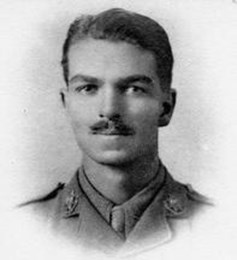
Above: 2nd Lieutenant Frank Alexander Rippingille
2nd Lieutenant (later A/Captain) Rene Frankland Gosset (1894-1916), 1st Battalion: b. Camberley, Surrey, 14 December 1894, only child of Colonel Edward Frankland Gosset psc (1857-1937), late East Yorkshire Regiment, and Mary Mabel Vidal (1865-1935); unmarried (his engagement to Irene, daughter of Lord and Lady Molesworth had been announced in March 1916); ed. Cheltenham College and RMC Sandhurst, commissioned 15 August 1914; initially attached to 2nd Battalion Duke of Wellington’s Regiment. It is unclear how long he served with 2nd Duke’s. He spent much of 1915 on sick leave and on recruiting duties at Faversham in Kent, near where his parents lived. He joined up with 1st East Yorkshire on 28 July 1916 and was put in “B” Coy. On 1 August he is listed as OC “A” Coy, with whom he was killed in action 25 September 1916, aged 21, possibly in front of Grid Trench in the first wave of the attack against Gueudecourt. 2nd Lieutenant Rippingille’s brother was wounded in the same attack. Captain Gosset is buried in Serre Road No. 2 Cemetery, France. Gosset’s father came out of retirement in September 1914 to become the first CO 19th (Service) Battalion King’s (Liverpool Regiment) (3rd Liverpool), but did not take the battalion to war. Service File: TNA: PRO WO 339/10652. Probate: £257 0s 0d.
Special Reserve
2nd Lieutenant Mark Robinson Pease (1892-1914), “D” Coy, 1st Battalion: b. Tranby House, Hessle, East Riding of Yorkshire, 14 October 1892, eldest of five children of Colonel Harold Robinson Pease (1859-1937) and Violet Hester Barkworth (1866-1956); unmarried; ed. Haileybury College and RMC Sandhurst, commissioned 10 July 1912; transferred to the Special Reserve4 July 1914. He was expecting to enter Jesus College, Cambridge, in October 1914, but was recalled to the colours at the outbreak of war; killed in action 20 October 1914, aged 22. Everard Wyrall gives an account of his death: ‘A subaltern (2nd Lieutenant Mark R. Pease) was heard to shout to his platoon: “Come along, lads, it is a fine thing to die a hero!” This brave young officer was unfortunately killed.’ Pease’s father came out of retirement in 1914 and commanded 12th (Service) Battalion East Yorkshire Regiment (3rd Hull), 1 September 1914-17 August 1916. 2nd Lieutenant Pease is buried in Houplines Communal Cemetery Extension, France. Service File: TNA: PRO WO 339/8205.
2nd Lieutenant Arthur William Meller (1883-1914), “A” Coy, 1st Battalion: b. Woolwich, Kent, 18 August 1883, son of Battery Sergeant-Major Arthur Meller RFA (1853-1922); unmarried; commissioned in the Special Reserve [SR] 4 April 1914; in the 1911 Census, he was described as a ‘Secretary’s Clerk’, working in Scarborough; killed in action 20 September 1914 on the Aisne, aged 30. 2nd Lieutenant Meller has no known grave; he is commemorated on the La Ferté-sous-Jouarre Memorial, France. Service File: TNA: PRO WO 339/30862.
2nd Lieutenant Thomas Reginald Bottomley (1887-1914), “C” Coy, 1st Battalion: b. Soyland, West Riding of Yorkshire, 17 October 1887; eldest of four children of Thomas Bottomley (1851-1930), cotton spinner, and Ellen Whiteley (1853-1927); ed. Rishworth Grammar School, Halifax Technical College, St John’s College, Battersea and Birkbeck College, London (BA, 1913); commissioned in the Special Reserve18 April 1914while working as a teacher in Croydon; married to Evelyn Mary Gibson (1883-1966) on 29 August 1914, deployed on 8 September 1914 and killed by a shrapnel bullet fifteen days later, aged 26. 2nd Lieutenant Bottomley has no known grave; he is commemorated on the La Ferté-sous-Jouarre Memorial, France, and on the University of London Roll of Honour. His widow appears not to have remarried. She became an American citizen in 1952 and died at Long Beach, California, on 1 October 1966. Bottomley’s younger brother, Norman, also served in the East Yorkshire Regiment before transferring to the RFC and the RAF. Air Marshal Sir Norman Howard Bottomley KCB CIE DSO AFC (1891-1970) succeeded Sir Arthur Harris as Commander-in-Chief of Bomber Command in 1945. There is a letter in his brother’s service file in which Norman’s CO at 3rd Battalion East Yorkshire Regiment requests on his behalf that Thomas’s officer’s sword be sent to him. Service File: TNA: PRO WO 339/10404. Probate: £179 17s 0d.
[1] We used the Army List of August 1914. This was published on 8 August 1914 and was, allegedly, correct up to 31 July 1914.
[2] 6th Division is now the subject of a fine divisional history by Peter Hodgkinson, A Complete Orchestra of War: A History of the 6th Division on the Western Front 1914-1919 (Warwick: Helion, 2019).
[3] If a Regular colonel was not promoted to major-general within five years, in order to stay in the army he would have to go on half pay. If not promoted within two years, he would have to retire.
[4] Peter Hodgkinson has pointed out that only one of 6th Division’s original infantry battalion commanders (Lieutenant-Colonel Cecil Higginson, CO 1st Battalion KSLI) had passed staff college. This was in marked contrast to the army as a whole, where 22 percent of Regular COs had passed staff college: see A Complete Orchestra of War, p. 85.
[5] Clarke was 1st Battalion’s fourth CO since the start of the war. There would be another seven by the end.
[6] Derek Clayton’s To Do the Work of Men: An Operational History of the 21st Division in the Great War is scheduled for publication by Helion in the spring of 2023.
[7] See Iris Oakey, ‘Problems of Morale, Discipline and Leadership in the 28th Division, January-October 1915’, Unpublished MA Dissertation, University of Birmingham, 2006. 28th Division, if it is remembered at all, is known for its time at Salonika, but it suffered very heavy casualties during its service on the Western Front and its war did not end with the Armistice but extended into operations in Turkey from 1919 to 1923.
[8] Brigadier-General J.E. Edmonds and Captain G.C. Wynne, comps., Military Operations France and Belgium 1915 [Vol. 1](London: Macmillan, 1927), p. 296
[9] 28thDivision’s travails on the Western Front are detailed in John Powell’s excellent study of its divisional commander, Edward Bulfin: Haig’s Tower of Strength: General Sir Edward Bulfin, Ireland’s Forgotten General (Barnsley: Pen & Sword Military, 2018).
[10] Powell, Haig’s Tower of Strength, p. 146
[11] Lieutenant-Colonel (later Brigadier-General) William Alan Blake CMG DSO (1875-1959)was the fifth permanent commander of the 2nd East Yorkshire during its time on the Western Front. There were only two more for the rest of the war, a comment on the demanding nature of battalion command on the Western Front. Blake commanded the battalion from 7 September 1915 to 10 October 1916 and again from 12 December 1916 until 4 February 1917, when he was promoted and given command of 77 Brigade, 26th Division. He commanded 77 Brigade, with an interlude, for the rest of the war. He had been a Captain in the Wiltshire Regiment when the war broke out. He was the second ‘external’ appointee to command the 2nd East Yorkshire. The first was Lieutenant-Colonel (later Brigadier-General) William Frederick Sweny CMG DSO (1873-1950), late Royal Fusiliers, CO 9 February-23 April 1915. Sweny later commanded 61, 72 and 41 Brigades.
[12] These were: 2nd King’s (Liverpool) Regiment; 2nd Somerset Light Infantry; 1st Yorkshire Regiment; 1st Duke of Wellington’s Regiment; 1st Royal Sussex Regiment; 1st South Lancashire Regiment; 2nd North Staffordshire Regiment; 1st Durham Light Infantry.
[13] These were, in addition to 2nd East Yorkshire: 2nd King’s Shropshire Light Infantry; 3rd King’s Royal Rifle Corps, 4th King’s Royal Rifle Corps, 4th Rifle Brigade, 1st Royal Scots, 2nd Gloucestershire Regiment, 2nd Cameron Highlanders, 1st Argyll and Sutherland Highlanders, 1st Royal Irish Regiment, 2nd Duke of Cornwall’s Light Infantry, 2nd Royal Irish Fusiliers, 1st Leinster Regiment (all 27th Division, Western Front and Salonika); 2nd King’s Own (Royal Lancaster Regiment), 1st King’s Own Yorkshire Light Infantry, 1st York and Lancaster Regiment, 2nd Northumberland Fusiliers, 1st Suffolk Regiment, 2nd Cheshire Regiment, 1st Welsh Regiment, 2nd Buffs, 3rd Royal Fusiliers, 2nd East Surrey Regiment, 3rd Middlesex Regiment (all 28th Division, Western Front and Salonika); 2nd Royal Fusiliers, 1st Lancashire Fusiliers, 1st Royal Munster Fusiliers, 1st Royal Dublin Fusiliers, 2nd South Wales Borderers, 1st King’s Own Scottish Borderers, 1st Royal Inniskilling Fusiliers, 1st Border Regiment, 4th Worcestershire, 2nd Hampshire Regiment, 1st Essex Regiment (all 29th Division, Gallipoli and the Western Front); 2nd Dorsetshire Regiment, 1st Oxford and Buckinghamshire Light Infantry and 2nd Norfolk Regiment served with 6th (Poona) Division and were captured at the fall of Kut, in Mesopotamia, April 1916.
[14] A Biographical Index of these officers may be found in the Appendix.
[15] The truncation of the Staff College course applied to officers who had entered in January 1913, who would normally not have graduated until December 1914, and more so to those who had entered in January 1914, who would normally not have graduated until December 1915. The latter group, included – besides Harvey - A.G.B. Bourne, C.N.F. Broad, B.N. ‘Boy’ Brooke, H.E. Franklyn, J.F.C. Fuller, C.W. Melvill and F.G. Spring, who went on to have significant careers in the Great War and beyond.
[16] Everard Wyrall, The East Yorkshire Regiment in the Great War, 1914-1918 (Kindle Edition, Location 176) states that ‘The strength of the 1st East Yorkshires on arrival in France was 27 officers and 958 other ranks’. This is based on an Appendix in the Battalion War Diary, which counts the battalion’s medical officer, Captain (later Lieutenant-Colonel) John Lawrence Wood MRCS LRCP RAMC (1881-1943), and its Quartermaster, Hon. Lieutenant John Horrocks (18??-1915), in the total.
[17] Until recently, the Commonwealth War Graves Commission recorded Scott’s death as taking place on 16 March 1918, but it has now accepted that this was a mistake and has made the correction in the Debt of Honour Register.
[18] The 1st Battalion East Yorkshire Regiment’s officer losses in 1914 were not unusual. See Table3.1 in Keith Simpson, ‘The Officers,’ in Ian F.W. Beckett& Keith Simpson, eds., A Nation in Arms (London: Tom Donovan, 1990), p. 69. The Table lists the officer casualties for the 1st Queen’s, 1st Norfolk, 3rd Worcestershire and 1st Northamptonshire regiments.
[19] Hodgkinson, Complete Orchestra of War, p. 65. 1st East Yorkshire’s losses are shown in Table 1.1, p. 66. Besides the fatalities, Captain Bogle, Captain Anderson, Lieutenant Inglefield, Lieutenant Sasse, Lieutenant Markham, Lieutenant Blacker,2nd Lieutenant Robson, 2nd Lieutenant Hartcup and 2nd Lieutenant Meller were wounded.
[20] Spencer Jones, ‘The British Army and the Problem of the Western Front, 1915,’ in Spencer Jones, ed., Courage Without Glory: The British Army on the Western Front 1915 (Solihull: Helion, 2015), p. 38
[21] See Saunders’s entry in the Appendix for the confusion about his date of death.
[22] The most successful infantry battalion commander of August 1914 was probably Lieutenant-Colonel (later General Sir) R.B. Stephens (1869-1955), the only man to rise through every level from battalion commander (2nd Rifle Brigade), to brigade commander (25 Brigade), to divisional commander (5th Division), to corps commander (X Corps). 2nd Rifle Brigade was not involved in the 1914 fighting.
[23] Peter E. Hodgkinson, British Infantry Battalion Commanders in the First World War (Farnham: Ashgate, 2015), pp. 47-8. Dr Hodgkinson adds, p. 48, that ‘On New Year’s Eve 1914 only 42 per cent of the original lieutenant-colonels were still in command of their battalions’. See also, Peter Hodgkinson, ‘The Infantry Battalion Commanding Officers of 1914’, in Spencer Jones, ed., Stemming the Tide: Officers and Leadership in the British Expeditionary Force 1914 (Solihull: Helion, 2013), pp. 293-313.
[24] Powell, Haig’s Tower of Strength, p. 99.
[25] I owe this information to Dr Derek Clayton.
[26] 6th East Yorkshire was the pioneer battalion of 11th (Northern) Division, seeing service at Gallipoli and on the Western Front.
[27] Captain Trimble, Lieutenant Wailes and 2nd Lieutenant Smallwood all commanded 2nd Battalion East Yorkshire Regiment between the wars.
[28] See the Appendix for confusions about Stow’s date and place of death.
[29] There is a detailed account of the accident that cost Captain Willats his life in the Staffordshire Advertiser, 23 December 1916.
[30] The four infantry brigade commanders were Lieutenant-Colonel (later Brigadier-General) F.W. Towsey DSO (GOC122 Brigade, 27 September 1917-8 June 1918), Major T.P. Barrington (GOC 118 Brigade, 15 April-7 July 1916), Major G.D. Price CMG (GOC 55 Brigade, 18 October 1916-9 November 1917)and Captain S.G. Francis DSO* (GOC 111 Brigade, 19 October 1917-Armistice).
[31] The two divisional commanders were Major (later Major-General) Arthur Daly CB CMG (GOC 24th, 15 September 1917-Armistice) and Captain (later Field-Marshal Sir) Cyril Deverell GCB KBE (GOC 3rd Division, 7 August 1916-Armistice). Deverell was CIGS after the war. Both Daly and Deverell had passed staff college.
[32] The five infantry brigade commanders were Major (later Brigadier-General) W. Allason DSO* (GOC 52 Brigade, 14 April 1918-Armistice), Lieutenant-Colonel (later Brigadier-General) C.R.J. Griffith DSO (GOC 108 Brigade, 4 December 1915-21 May 1918), Captain (later Brigadier-General) W.H.R. Dann DSO* (GOC 60 Brigade, 5 June 1918-Armistice), Major (later Brigadier-General) C.C. Onslow DSO (GOC 57 Brigade, 16 June-20 July 1916,and 7 Brigade, 30 August 1916-9 August 1917).
[33] Captain (later Air Vice-Marshal Sir) Tom Webb-Bowen KCB CMG (GOC II Brigade RFC, 1916-17; 1918-19).
[34] Major (later Brigadier-General) G.D. Jebb DSO (DA&QMG X Corps and XV Corps). Jebb was a staff college graduate.
[35] Captain (later General Sir) Henry Jackson KCB CMG DSO (GOC 50th (Northumbrian) Division TF, 23 March 1918-Armistice). Jackson was a staff college graduate.
[36] E.L. Spears, Liaison, 1914 (London: William Heinemann, 1930), p. 373
[37] For this, see Andrew Lambert, The British Way of War: Julian Corbett and the Battle for a National Strategy (New Haven & London: Yale University Press, 2021)
[38] The Commonwealth War Graves Debt of Honour Register gives his date of death as 29 September 1914, but this is incorrect.
[39] The Commonwealth War Graves Debt of Honour Register, Officers Died in the Great War and Saunders’s entry in The Distinguished Service Order 1886-1923 give 30 May 1918 as his date of death. Saunders was originally posted ‘wounded and missing’, but his body was never found. His date of death ‘for official purposes’ was not accepted until January 1919 – the accepted date was 30 March 1918. This is confirmed by his service file, his Medal Roll entries, the Clifton College Register and Jamaica’s Part in the Great War, p. 118, which gives his place of death as Hangard Wood. The CWGC has now accepted 30 March 1918. I am grateful to Andy Johnson for his help in clarifying Saunders’s date of death.
[40] If 30 March 1918was his date of death and Hangard Wood the place, as appears to be the case, this suggests that his name should be on the Pozières Memorial, not the Soissons Memorial.
[41] The CWGC recently accepted that Scott’s date of death and age had been incorrectly listed and made the necessary changes in the Debt of Honour Register. His headstone will be corrected in the fulness of time.





